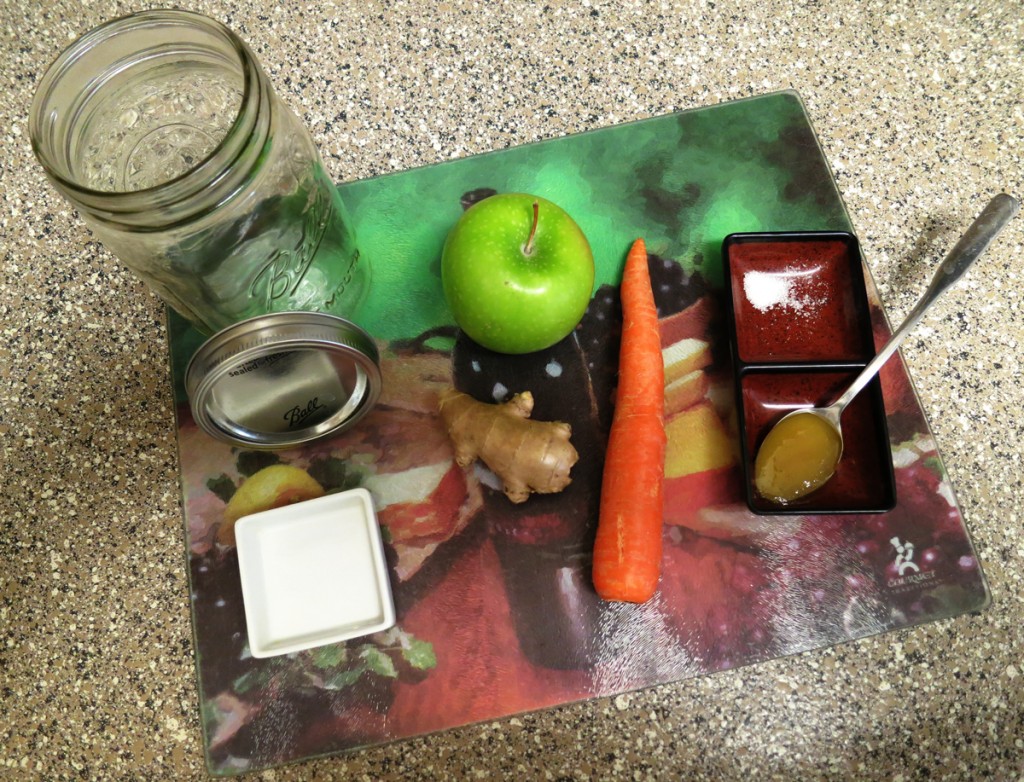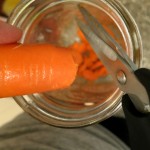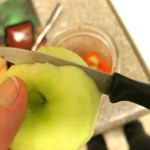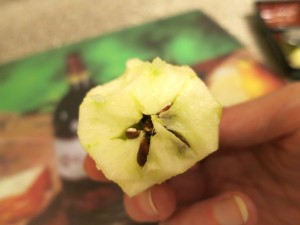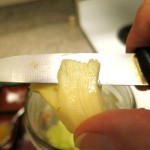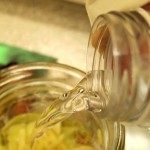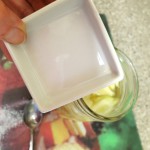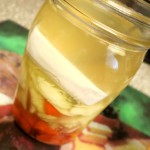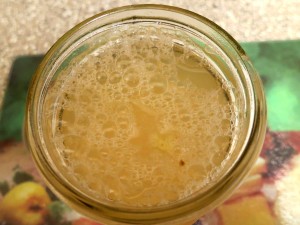Tag : easy
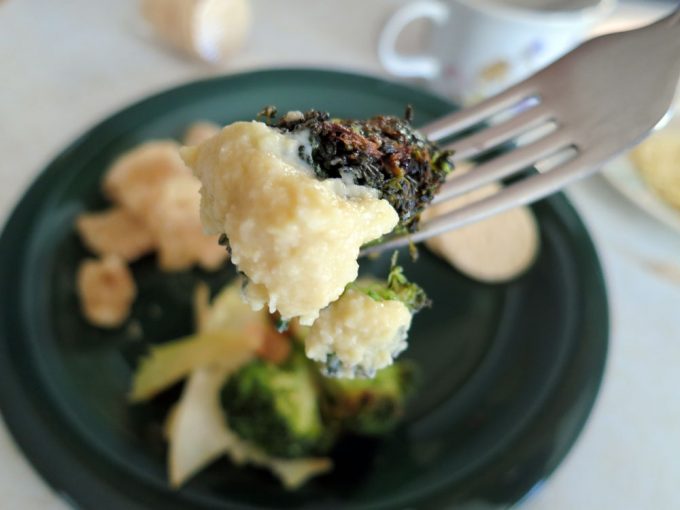
This is a quick, homemade hummus recipe that is easy and tastes out of this world, not to mention cheap as hell and nutritious to boot – all of which are why it is so sexy. I’ve made it for unsuspecting guests, for parties…and sometimes I just make up a whole batch and eat it in one or two sittings over a good read.
It has just four ingredients: canned garbanzos, a little olive oil, one clove garlic and half a large lemon (or a whole small one):
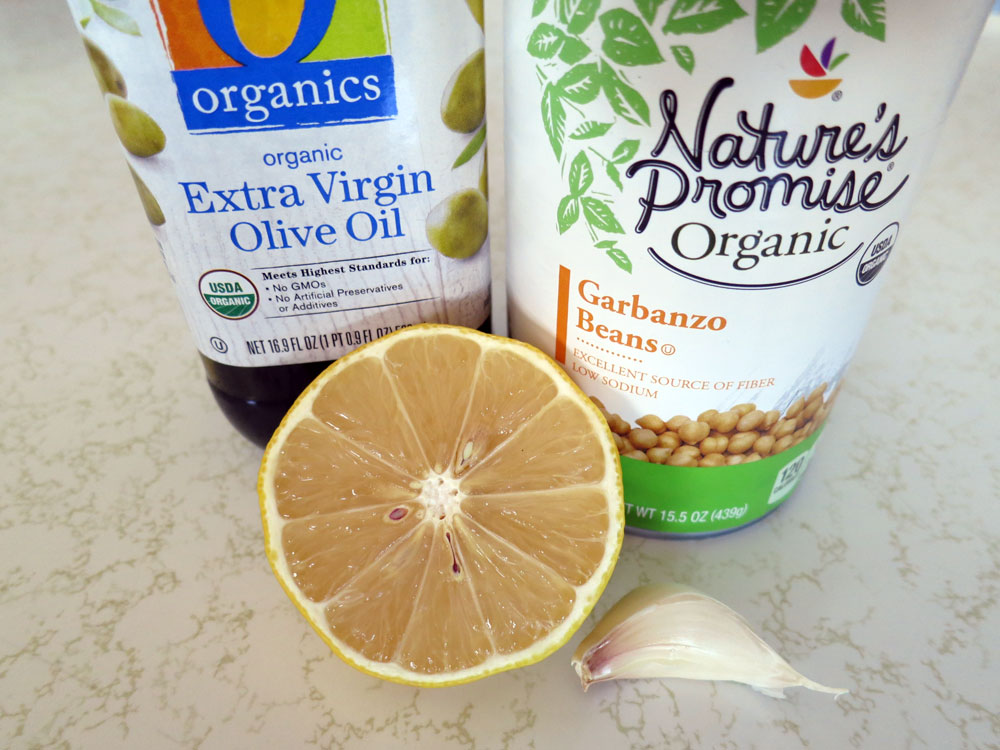
- 1 can organic garbanzos (15 oz or 425 ml)
- 1 tb or 15 ml olive oil
- 1/2 large or 1 whole small lemon
- 1-2 sections of garlic (to taste)
*Note that I’ve not included tahini – neither you nor your wallet will miss it.
You’ll also need a blender or personal blender, such as the one I have…
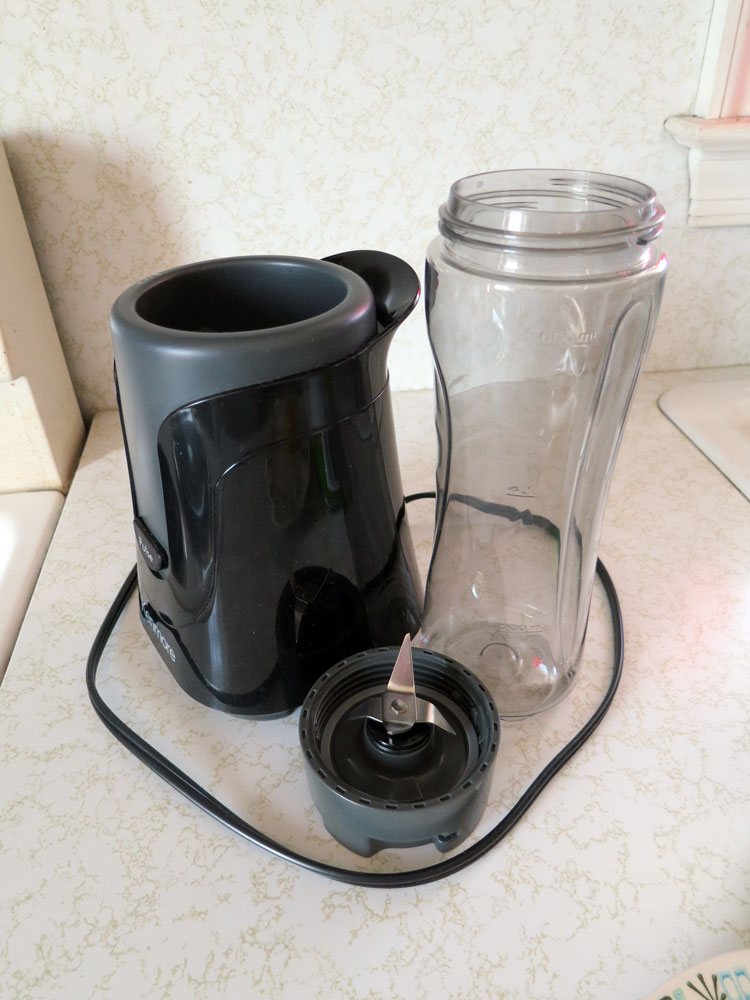
First, I spoon out the garbanzos into the blender and pour about 1/3 the liquid in with it. I also reserve 5 or 6 whole garbanzos as optional garnish for the finished hummus:
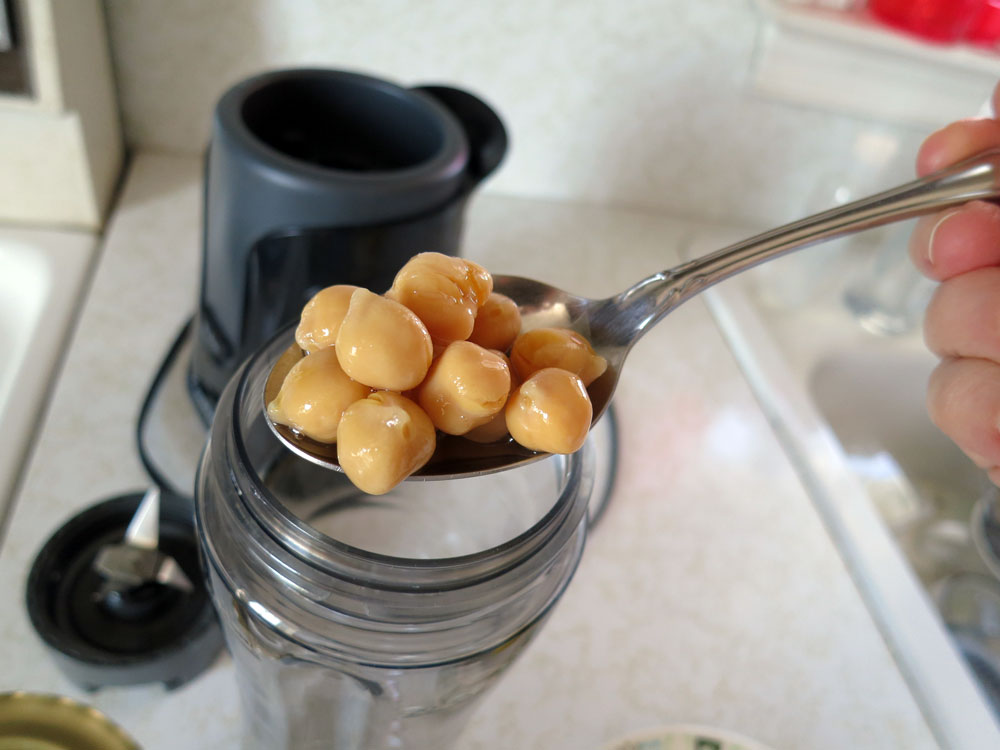
Next, squeeze the lemon into the blender:
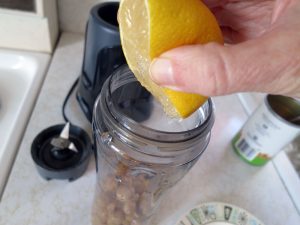 Once again, use about half of a large lemon (and note that mine had thin skin and lots of flesh to juice from) or a whole small one.
Once again, use about half of a large lemon (and note that mine had thin skin and lots of flesh to juice from) or a whole small one.
Then, slice up the garlic and add the olive oil (here, I’m eyeballing the olive oil, but if you’re looking for specifics, use a tablespoon, or 15 ml):
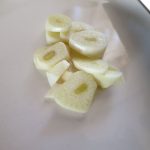
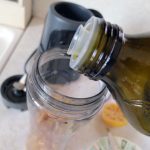
Now, swish or swirl the ingredients just a bit before blending. Place your blender’s cover on and blend using pulses until you get a uniform consistency…
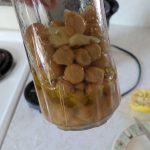
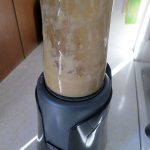
Pour and/or spoon out the hummus into a nice bowl or ceramic cup, as I’m using here, and refrigerate what’s left over:
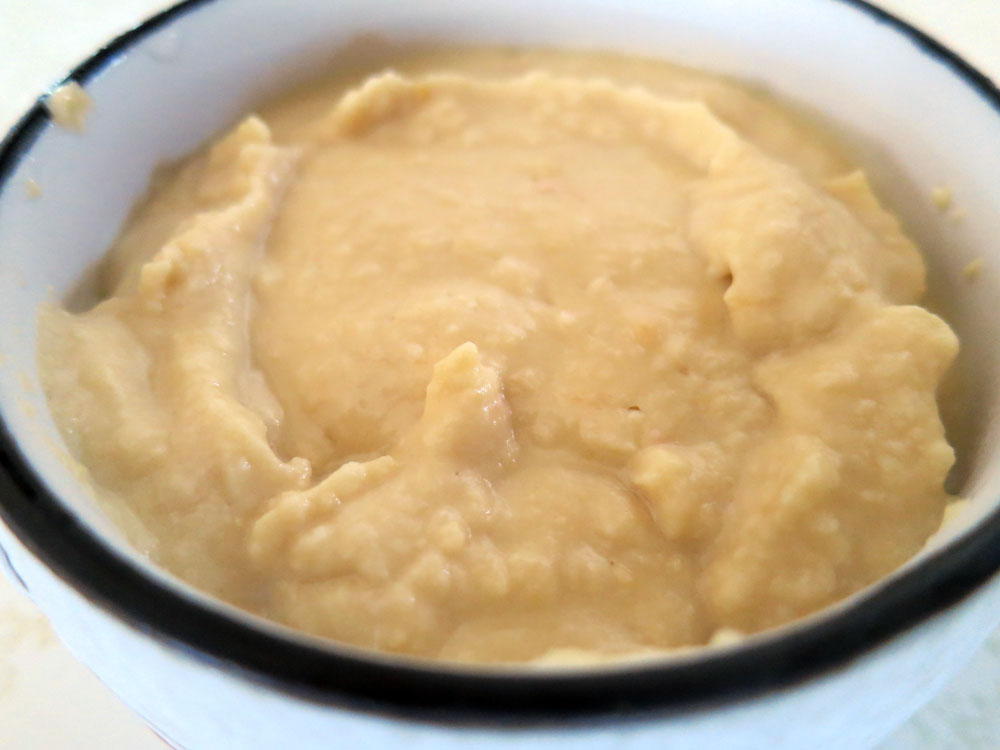
This makes for a great party or dinner snack dip, or even a small meal when you eat the entire following plate yourself:
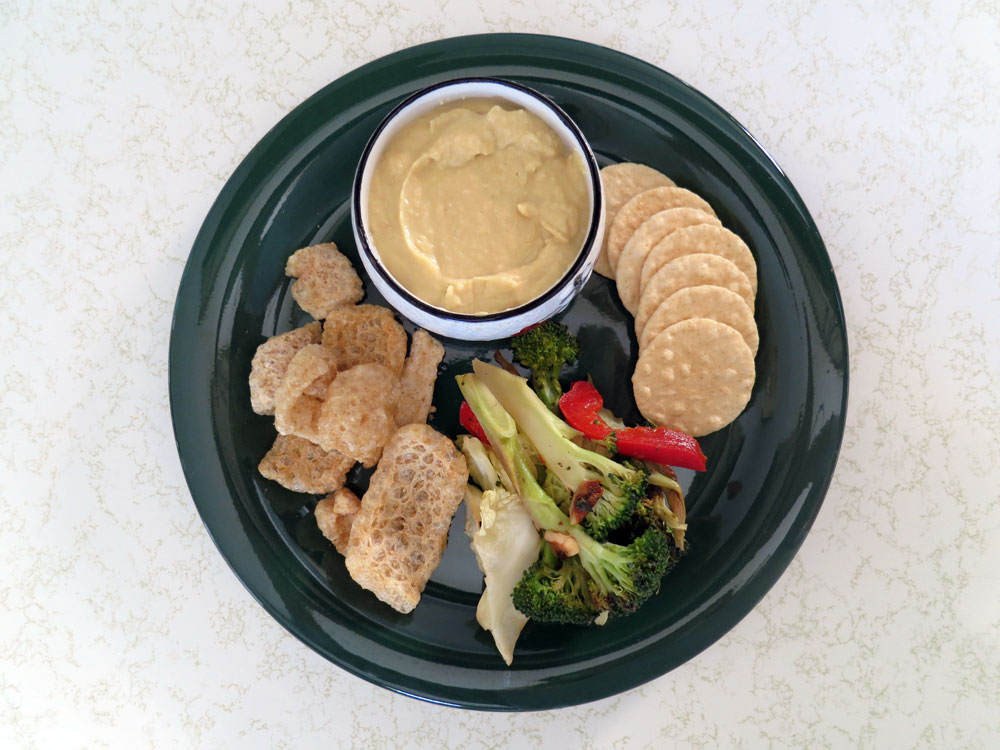
So, what on earth are pork rinds doing in this mix? Try them with the hummus – you just may really like them, especially if you’ve gone keto or follow another lower-carb/higher-protein set of eating habits.
This hummus goes with just about everything – I’ve even used it on salads, chicken, and on homemade pizzas to cut the cheese (pun intended – garbanzos may have you going a bit gassy!) amount in half so it lasts me a bit longer.
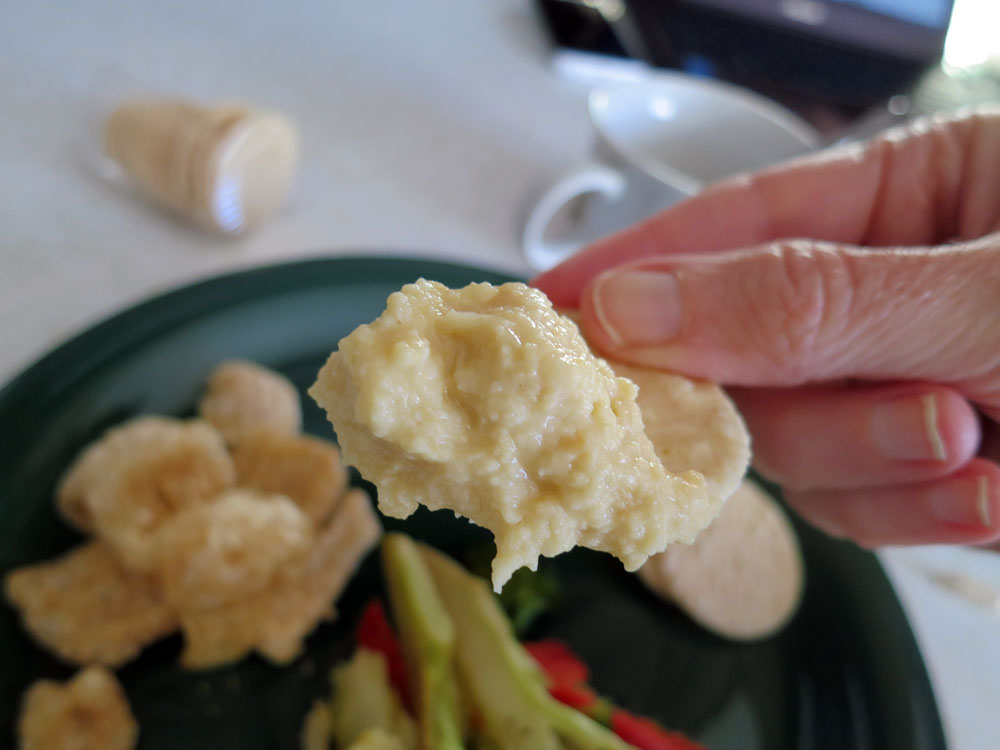
Given that the olive oil was $4.99 for 16.9 oz, the garbanzos were $.99 for a 15-ounce can, the section of garlic came from a 50-cent bulb, within which there were a dozen or so cloves, and the lemon was $.75. So…here’s the price breakdown:
- 1/2 lemon…. $.38
- 1 tb olive oil..$.16
- 1 section garlic…$.04
- 15 oz can garbanzos…$.99
All told: $1.57 for about 15 ounces of homemade hummus … now, compare that to what you’re paying at the supermarket! They charge TONS for hummus you can make in about five minutes…and if you double the recipe, it’s $3.14 for about 30 ounces.
Have fun!
Bon appetit, stay safe…and eat healthy!
Alison
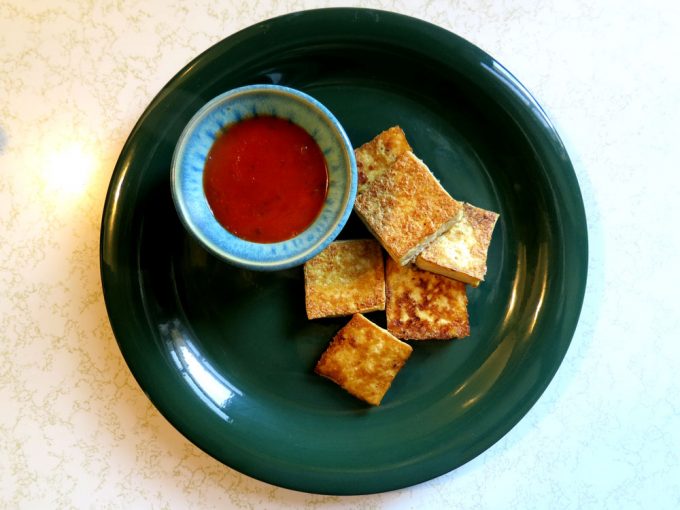
The first time I had braised tofu, it was at a local Chinese restaurant in Doylestown, Pennsylvania called Golden Chopsticks. It was served with a delicious veggie sauce on top. So heavenly – and so damn simple and inexpensive to make at home!
My favorite toppers for this quick and easy dish include tomato sauce and parmesan cheese, salad dressing, salt and vinegar – and ultimate fave Tasty Bite Indian Jaipur Vegetables. But really, any Indian or other sauce-based dish goes well with these delish golden-brown tofu squares, which resemble paneer, but with a snappy, crispy-soft texture that will have you making more batches of these on a regular basis.
They store quickly and easily into the fridge, where they’ll stay fresh for a few days – if they last that long. For meals and snacks, I take a few out, and pair them with whatever moves me – sometimes I julienne them onto an arugula salad and drizzle on some of Brianna’s awesome Creamy Balsamic dressing…or just place a few on a plate with some steak sauce, cut fresh carrots and perhaps a little cilantro on the side.
Not only are they easy and versatile, they only really have two ingredients – tofu and oil – in addition to whatever condiments you like:
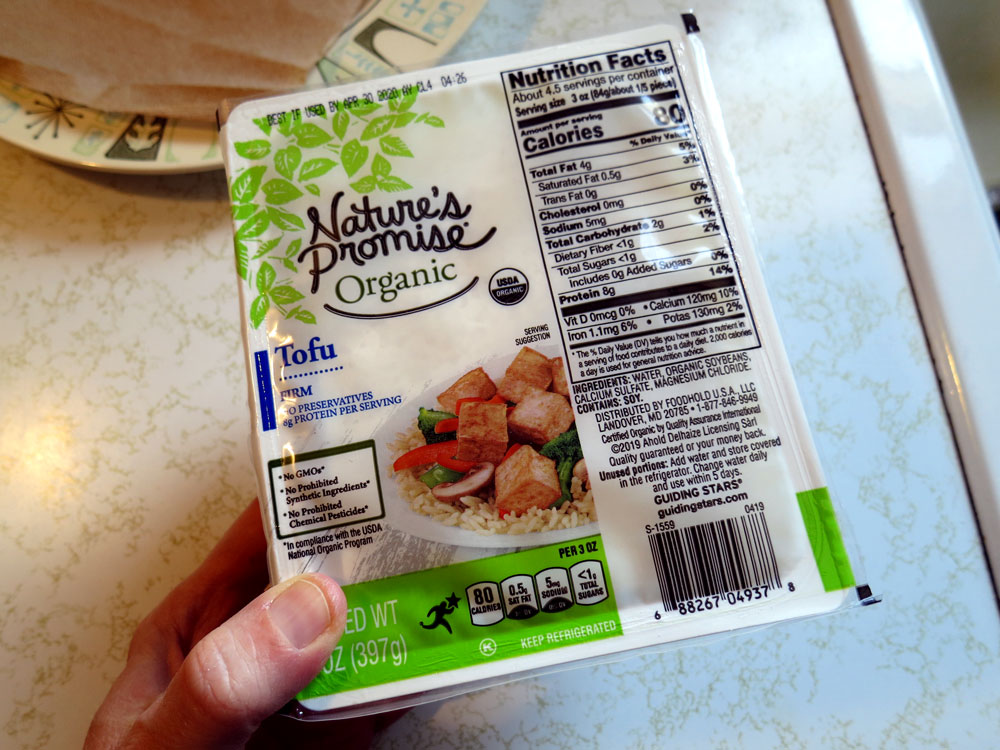
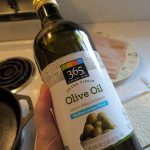
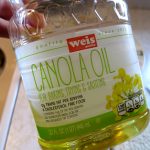
- 1 package firm or extra firm organic tofu (usually just under a pound, or 400 grams)
- Cooking oil of your choice (I mostly use canola* and/or olive oil…and use just enough to thinly coat the bottom of a skillet)
- Condiments of your choice
*Canola oil was chosen for its low saturated fat profile (and as a money saver). Choose any oil that is right for your purposes, but be wary of the saturated fat content.
You’ll also need a skillet, a sharp knife, a stove or fire…
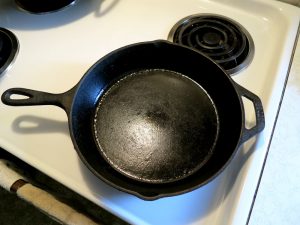
…and a small, broken, much-loved and handle-less spatula of your choice. I kid you not, it makes turning these little squares over in a hot oily pan a piece of cake:

First, set your stove burner to just about medium, then open up your package of tofu and slice it…I usually slice it long-ways in half first, then into sevenths width-wise, then blot the squares on a napkin to shorten the cooking time…
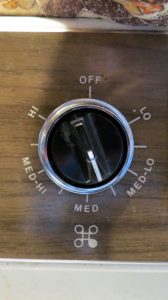
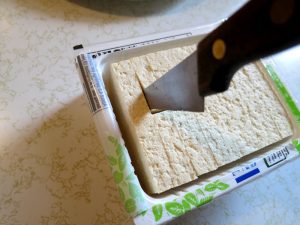
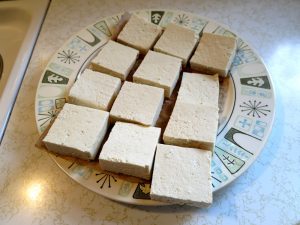
After blotting the tofu squares for a few minutes, carefully place them into your heated and oiled skillet:
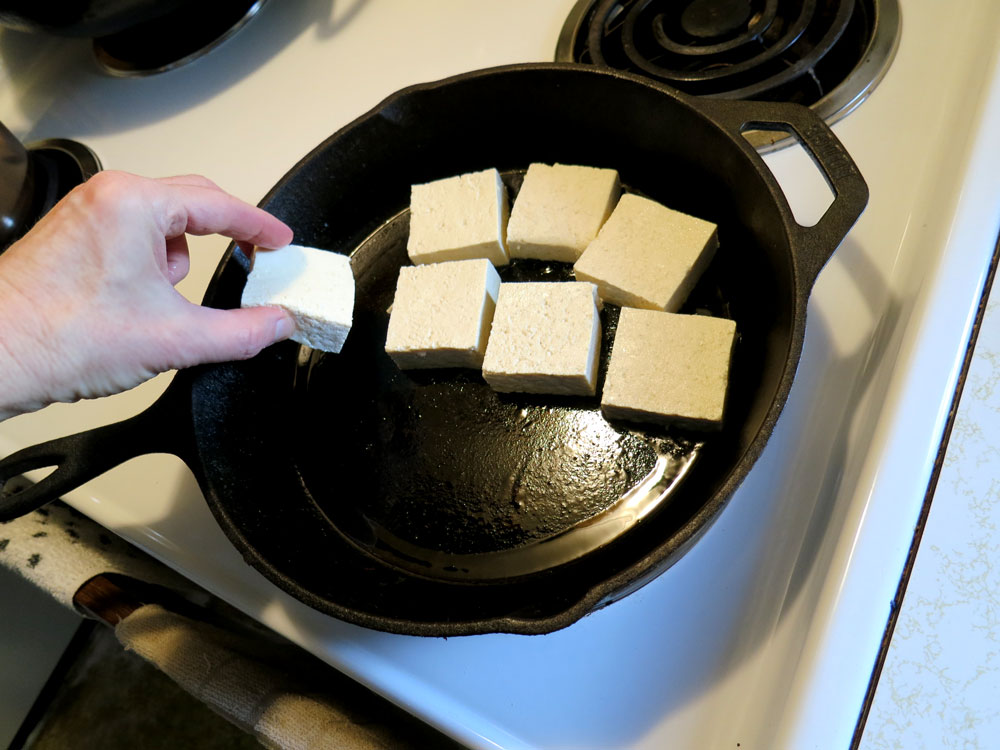
I find that 14 squares fit perfectly into my 10-inch / 25.4 cm iron skillet…
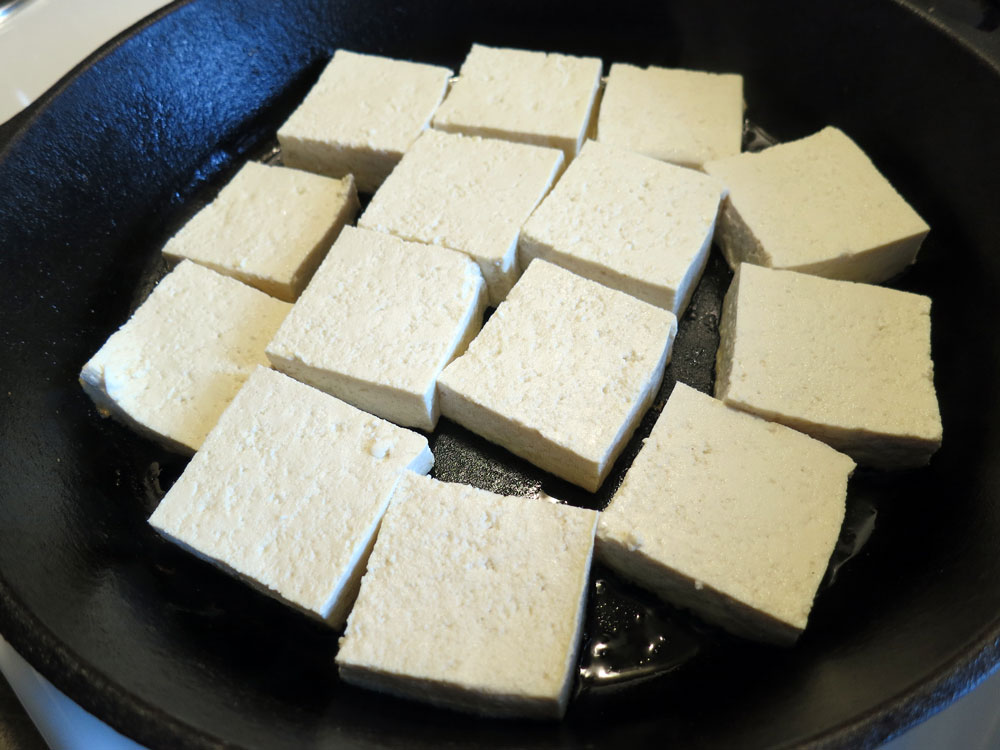
Let the squares cook on medium heat for at least 5 minutes, if not 10. The first side can take some time to cook to the desired texture because tofu has a high moisture content.
When you start to see the browning of the squares at the bottom edge, that’s when it’s safe to lift these little babies up without tearing them apart to check for doneness:
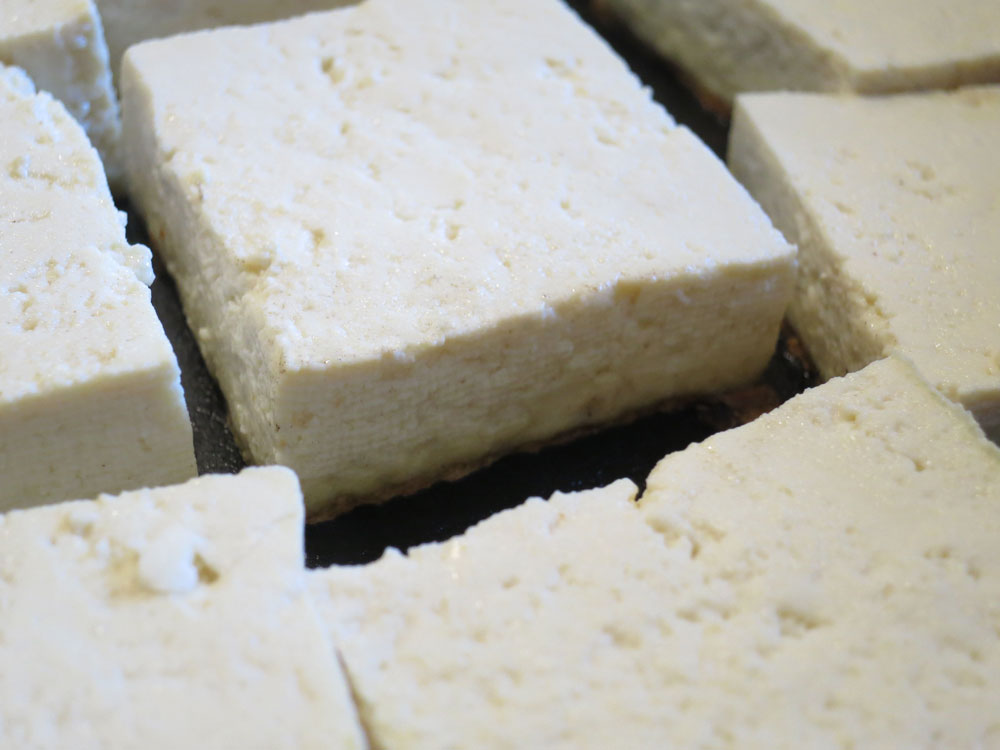
If you don’t wait until you see the browned edges, you risk breaking up the squares quite a bit. A little patience goes a long way!
Take your broken small spatula and gingerly lift up the browned-on-the-bottom square like so…
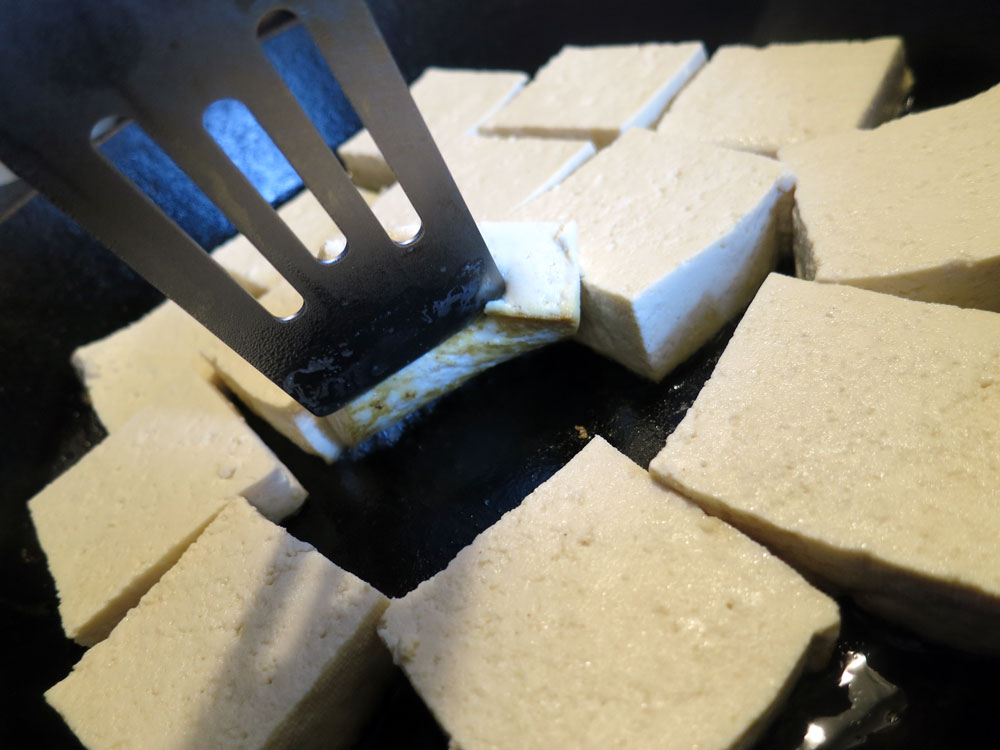
If your squares look solidly golden-brown like in the picture below, they are ready to turn over!
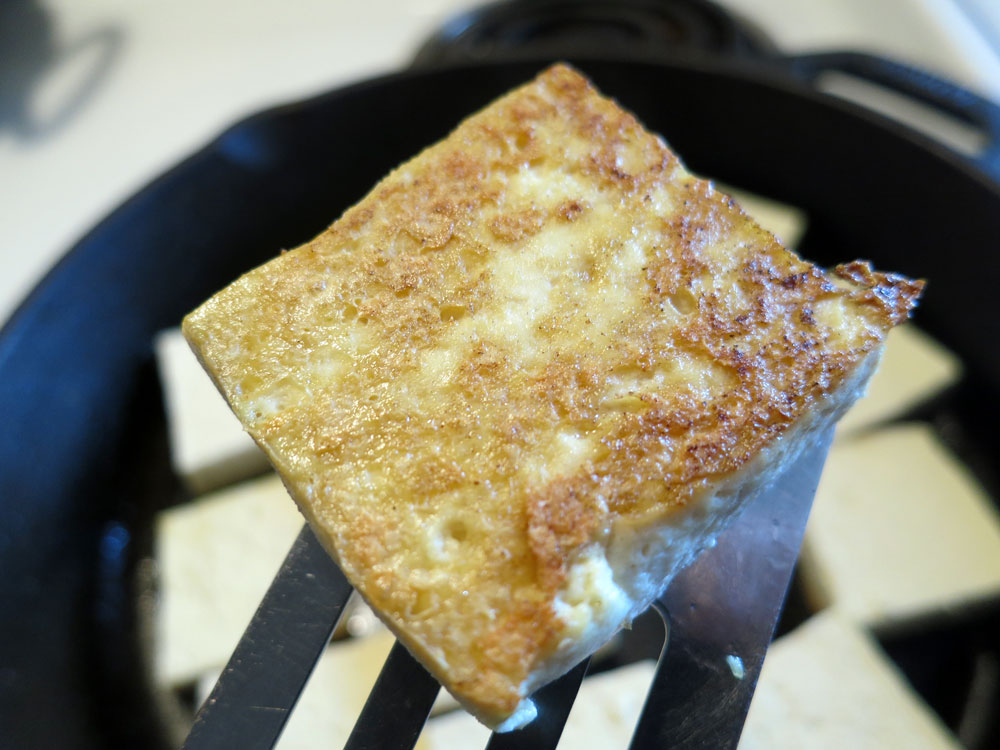
Cook the other sides of the squares for several more minutes, keeping a close watch on them. Usually, the second sides take a little less time than the first.
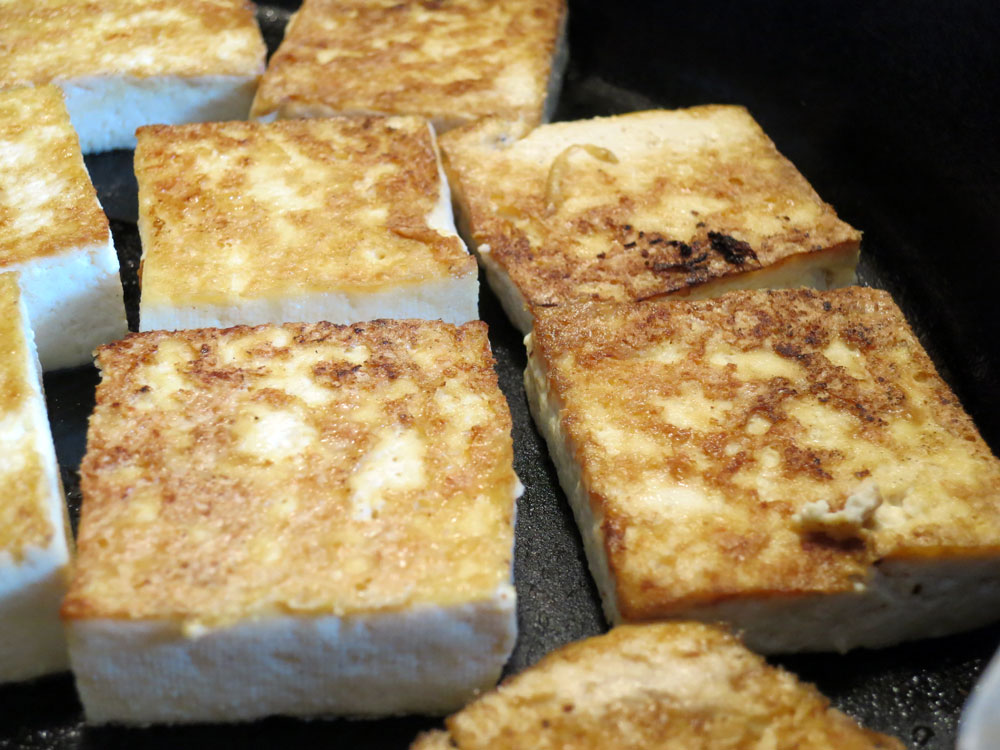
Keep watch until you see the brown bottom edges again. When both sides are done, they are ready to be removed from the pan…
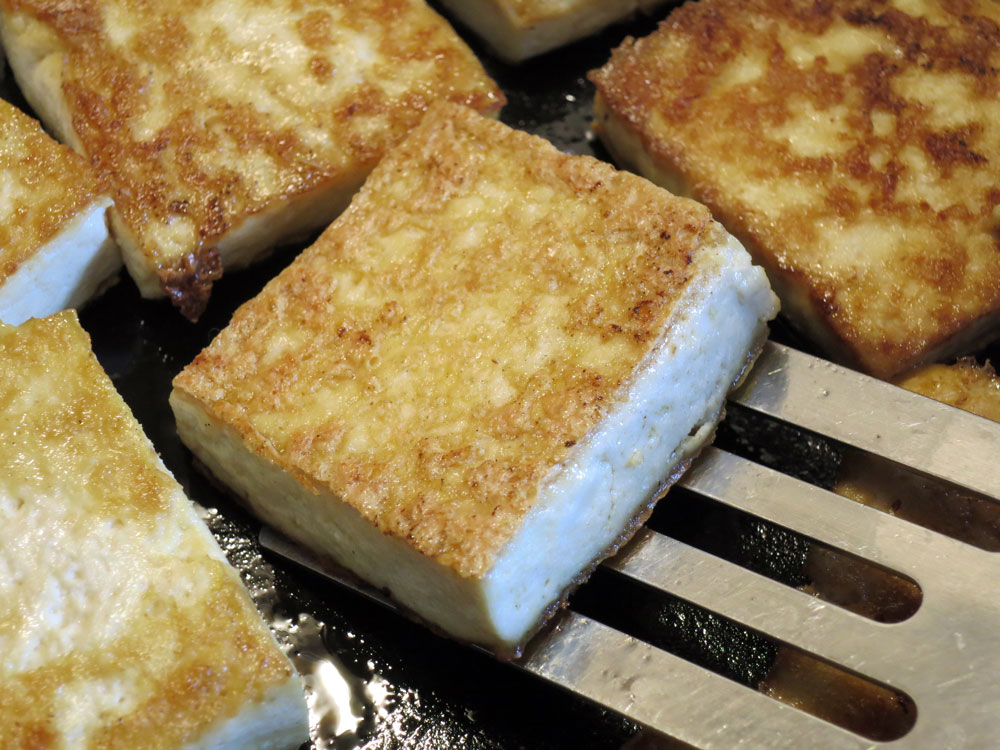
Serve them on a plate…sometimes I just eat them plain, or with a little salt and vinegar (if you find soy or tofu hard to digest, some vinegar really helps)…or even a healthy dusting of cinnamon and stevia:
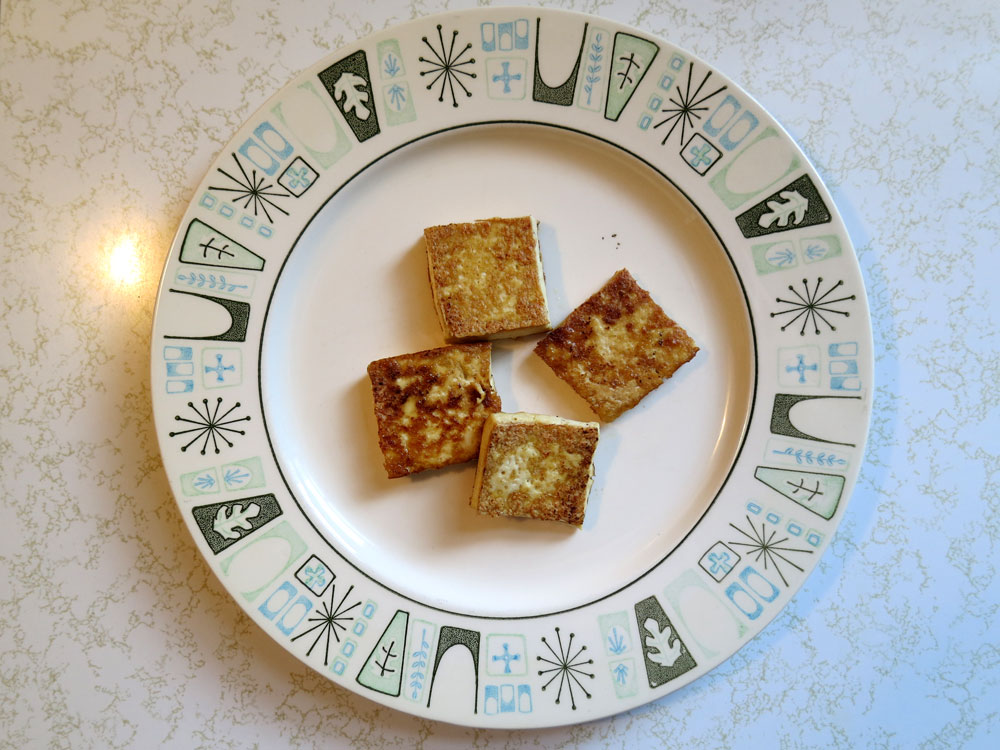
These are quite good by themselves, the crispy-soft texture contrast is just fantastic!
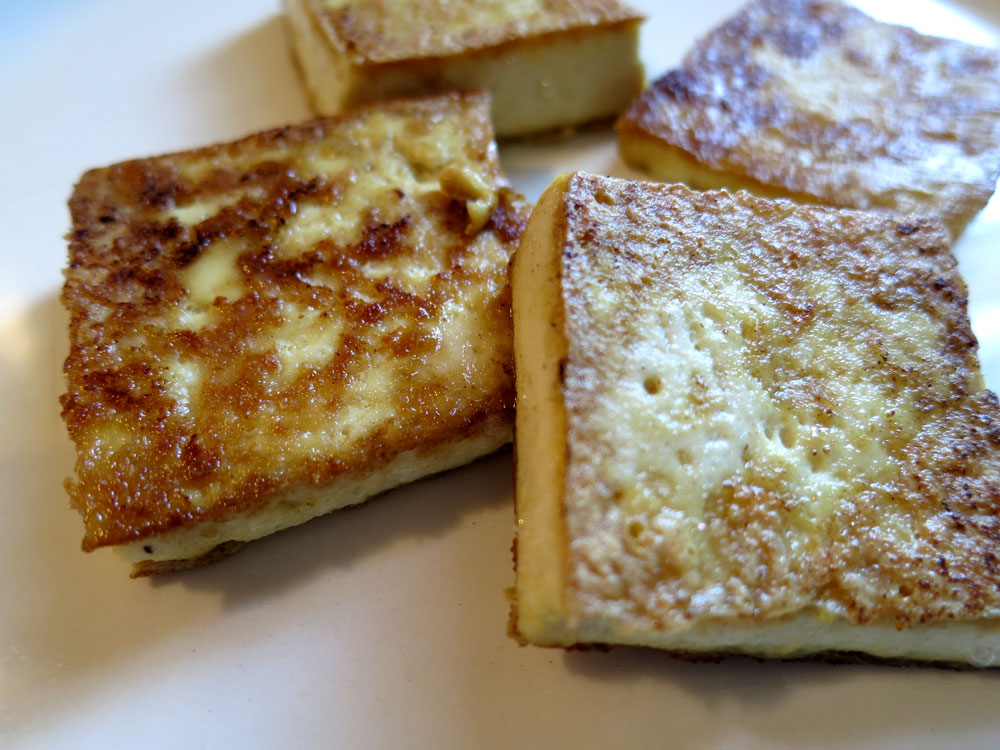
…and these little beauties are a hit at parties (and poker games, as I found out around two months ago during the holidays).
They are wonderful with tomato sauce (or even steak sauce) and served on a pine-needle green plate…
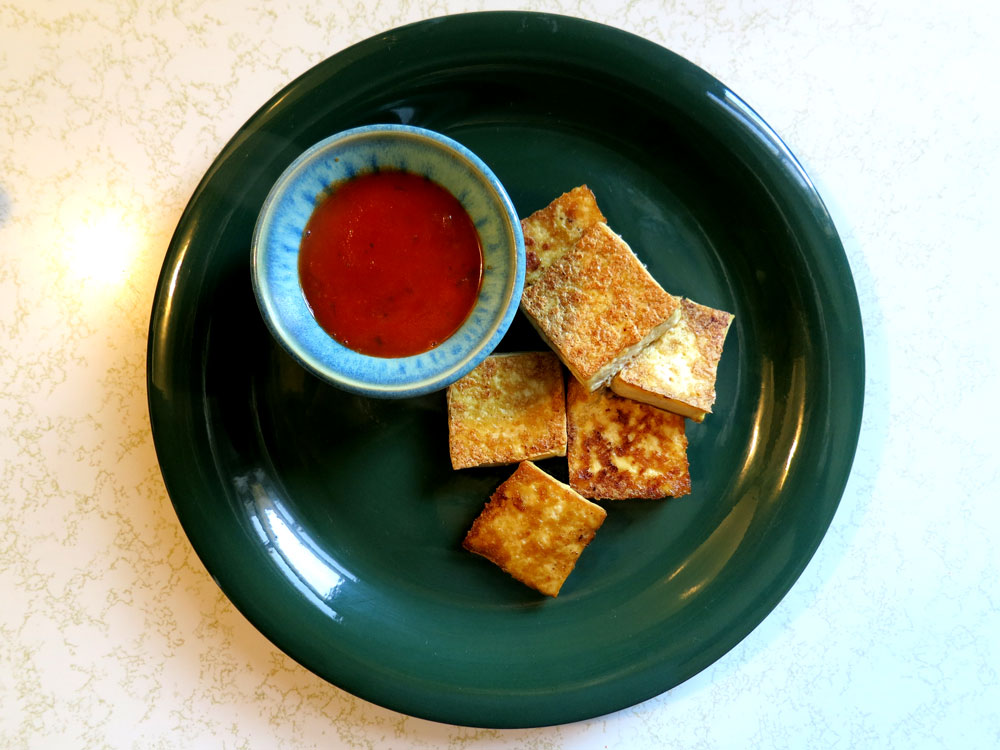
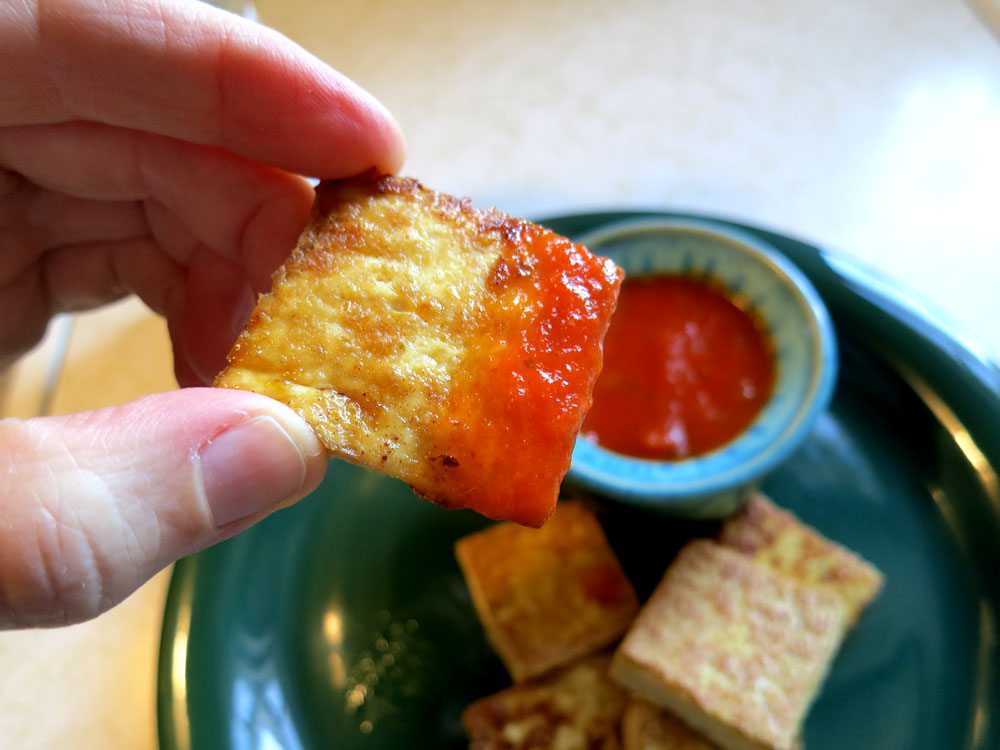
…they also pair very well with salad dressings, and are a great topping for salads…
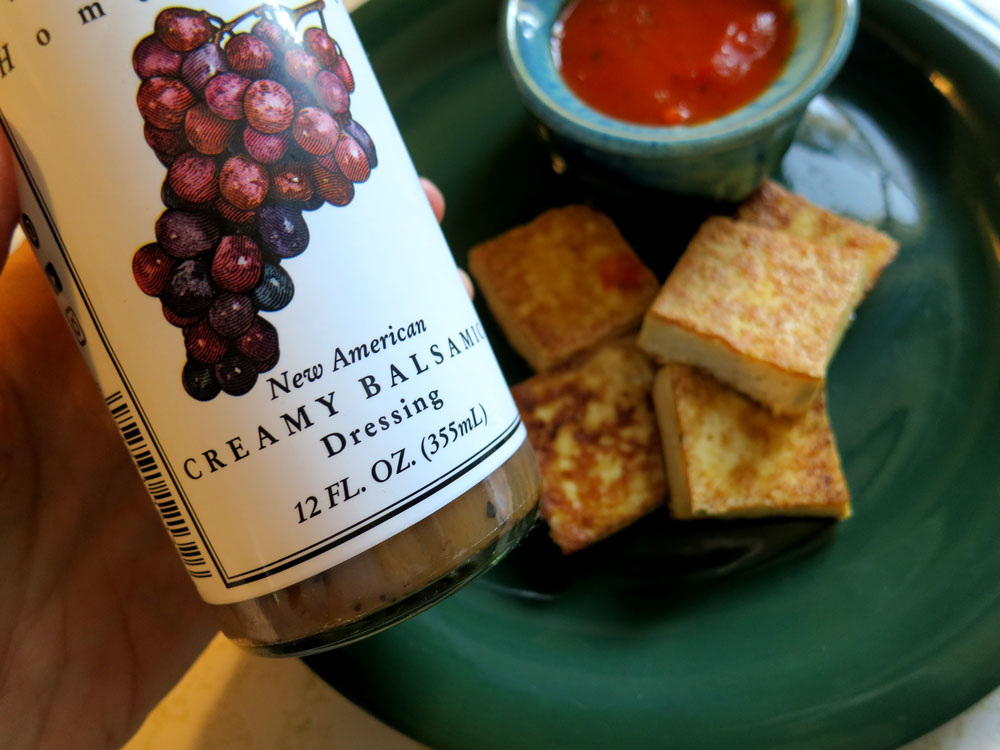
…and with one of my other faves, Tasty Bite Indian meals!
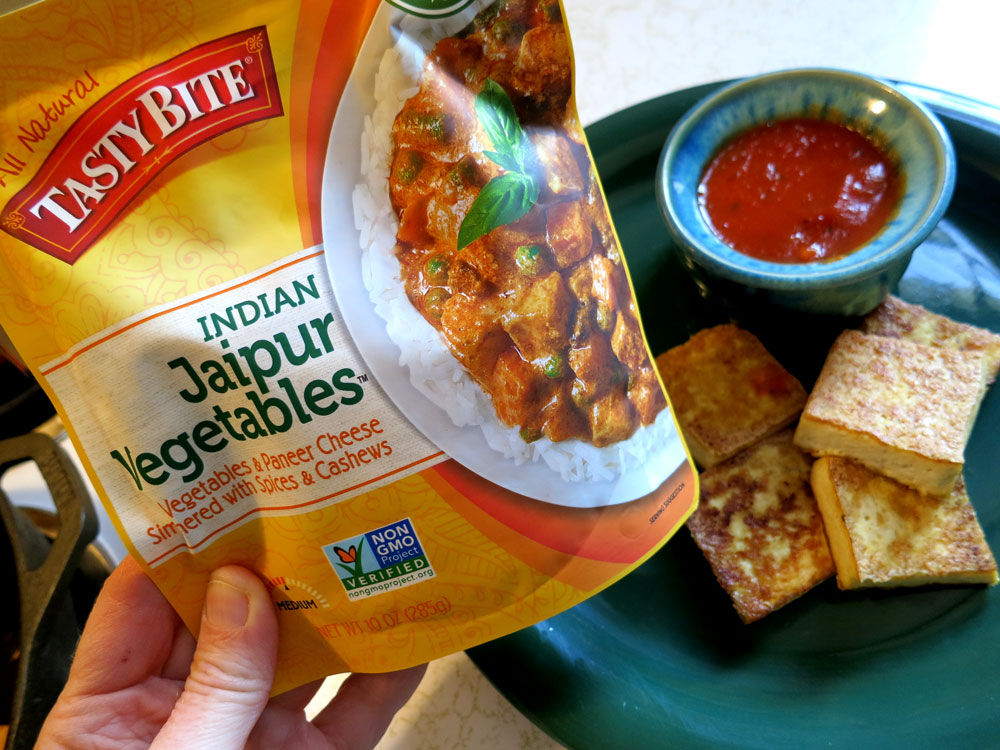
Any way you use these, they are a very tasty time saver…keep them in your fridge for when you want some quick, delicious protein!
Enjoy!
Yours in Great Health,
Alison
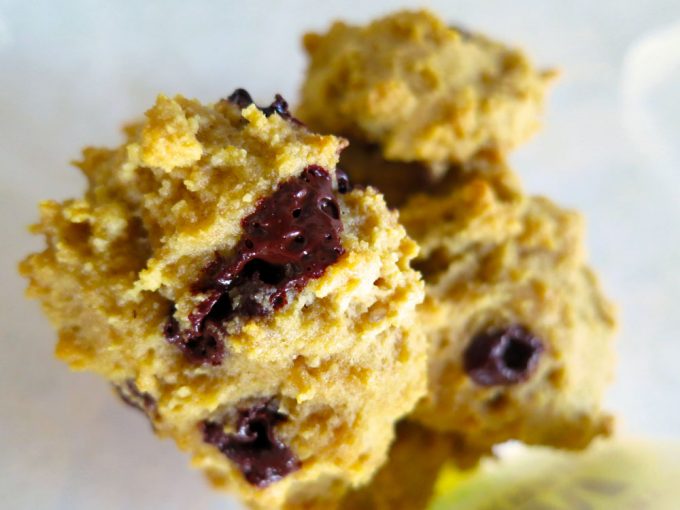
This fast, easy and naturally sweet, but very low carb and low fat chocolate chip cookie recipe uses two of my favorite things, almonds in the form of almond flour, and chocolate chips. These are not just any chocolate chips, however – they are sugar free, nothing but 100% chocolate, and amen to that. For a while, baker’s chocolate had to suffice – along with time spent chopping it up, which wasn’t pretty.
Sugar, along with sugar alcohols, artificial sweeteners and other additive sweeteners like agave, are so overused in our food supply that it is truly rare to find an unadulterated, unsweetened product like Pascha Organic Dark Chocolate Baking Chips, which are 100% cacao, and nothing else. These chips are unsweetened, nut free, wheat and gluten free, and dairy and egg free as well as free from soy.
A product of Peru made for the Pascha Chocolate Company in Toronto, Canada, I found my curiosity piqued and visited their site to see the bag of chips on their front page along with that ever-so-important tagline: One Ingredient. One of their site’s main menu categories is “Free From.” It’s what I look for most of the time these days, simple things without all the BS in order to keep the “cup runeth over” diseases and syndromes at bay.
Recommendation made, so let’s get to the recipe, which is super quick and easy. You’ll need:
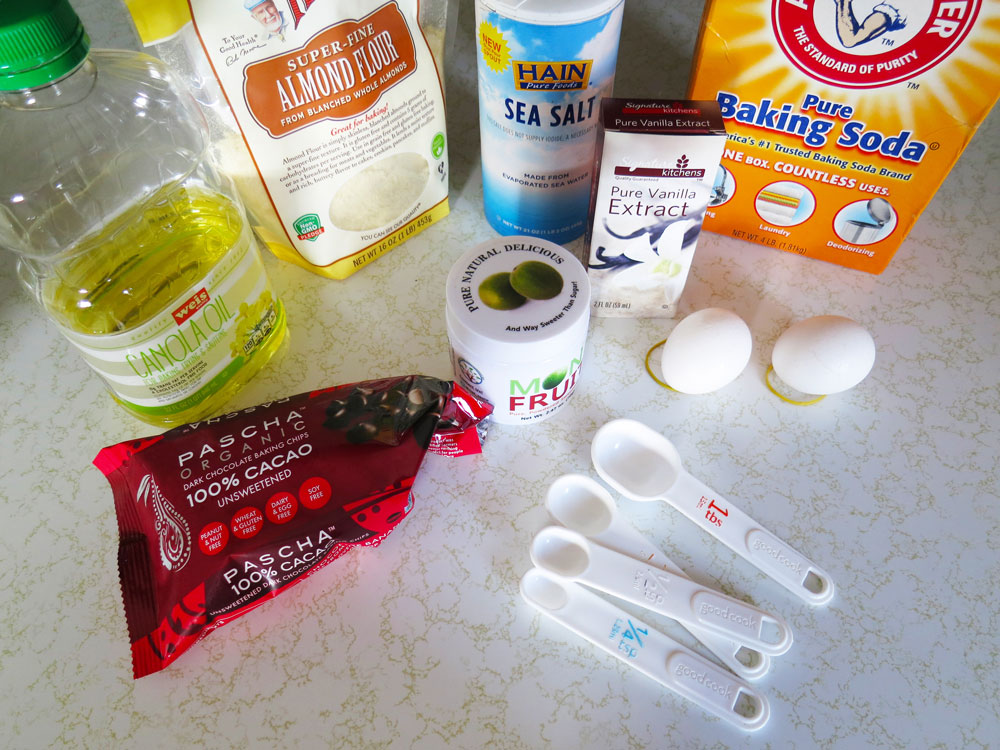
- 250 ml fine almond flour (I use blanched almond flour)
- 2.5 ml baking soda
- 1.25 ml sea salt or Himalayan salt
- HEAPING 2.5 ml spoonful monk fruit powder
- 1 whole egg
- 1 egg white
- 10-15 ml *canola oil (or other fave oil)
- 2.5 ml vanilla extract
- 1 small handful 100% cacao chocolate chips, to taste…and a little goes a long way!
*Canola oil was chosen for its low saturated fat profile (and as a money saver). Choose any oil that is right for your purposes, but be wary of the saturated fat content.
Combine all ingredients except chocolate chips in a medium-sized mixing bowl, like so…
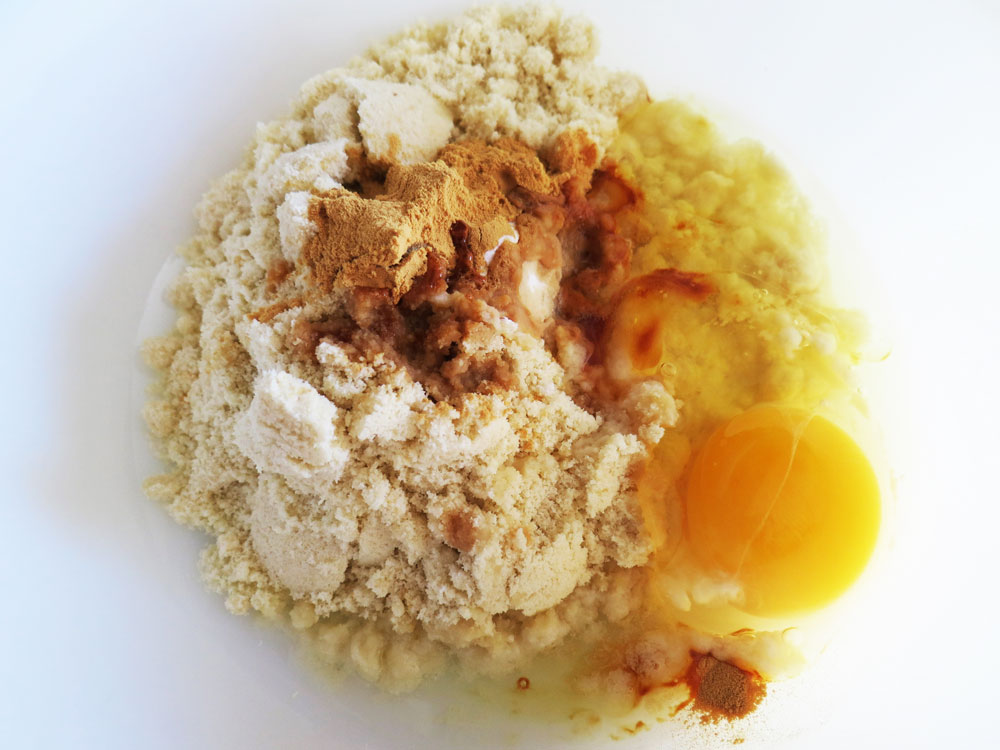
…and mix all ingredients until the dough is uniform:
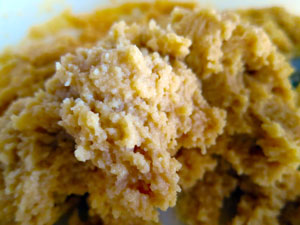
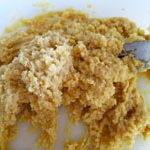
Next, add in your delicious, decadent-without-the-shite chocolate chips. Enjoy these photos…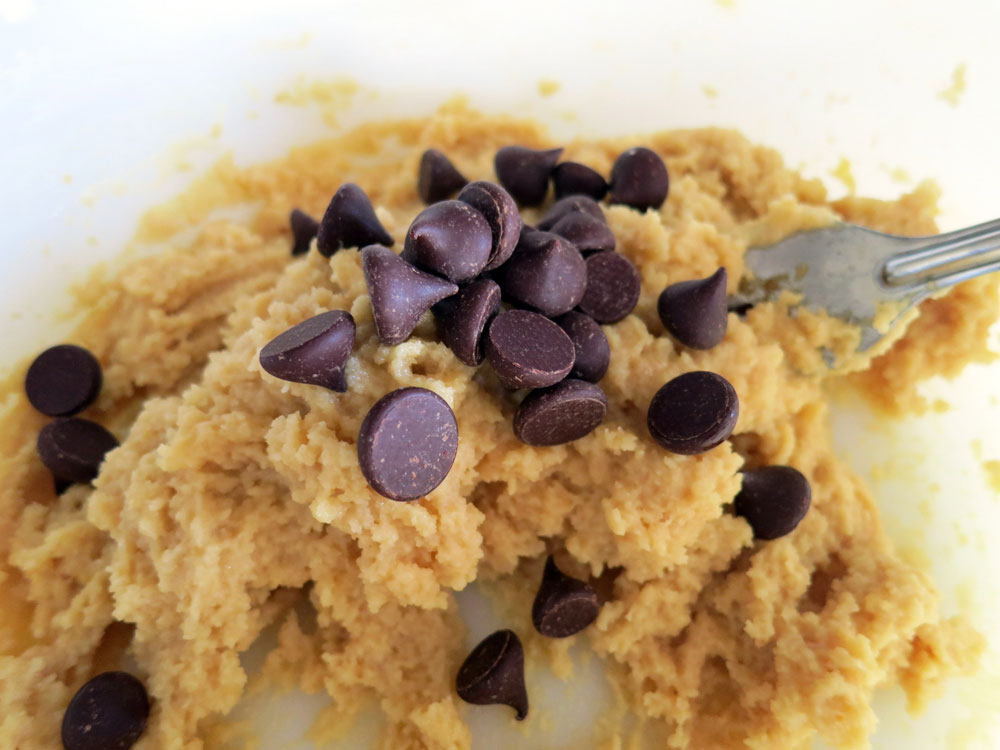
…I could take an extended, slow, sensual bath in this stuff…
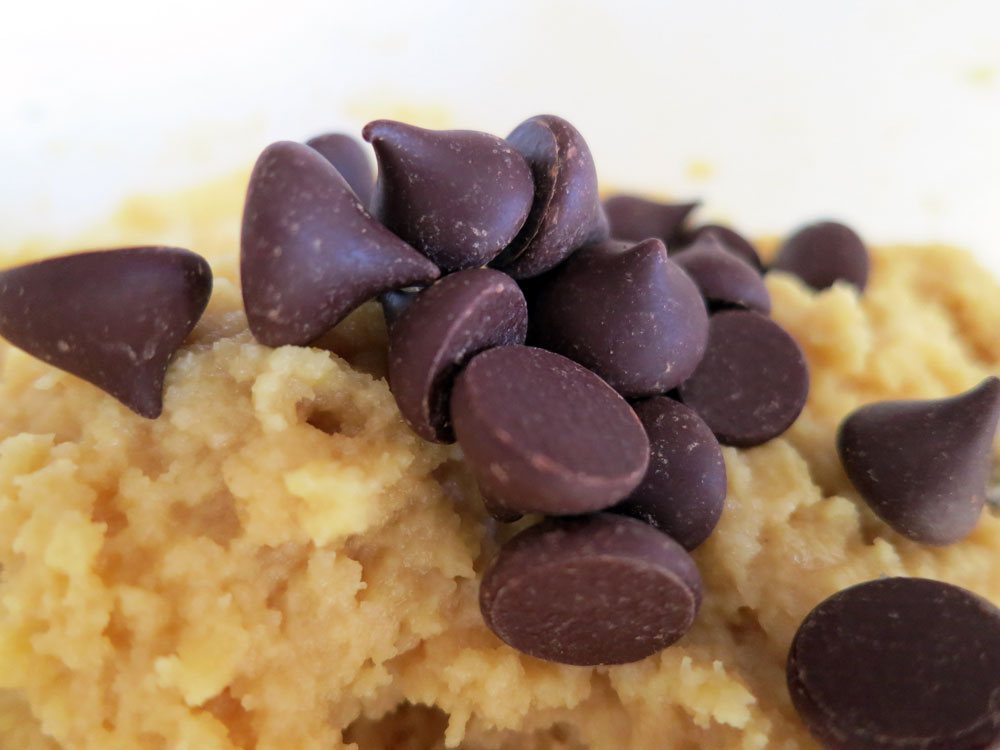
…and I’d do it all day if I could stave off my chocoholism for long enough. But, having preheated the oven to 375 Fahrenheit degrees on a hot day, I gotta get back on track here.
After mixing in the chocolate chips, take two regular flatware teaspoons and spoon out the dough in small dollops – about 2.5 cm or an inch or so in circumference each – onto a baking sheet or whatever you have available. As all my other baking sheets are out on other projects at the moment, I’m using the oven’s broiling pan, which turns out to be better than the baking sheets I’ve been using. It has enamel instead of that chemicalized non-stick material that is now lodged in all our body tissues, is better than that crappy non-stick anyway, and it also makes for a great contrast with the little No-No dollops. They kind of look like little space cookies, don’t they? Cute!
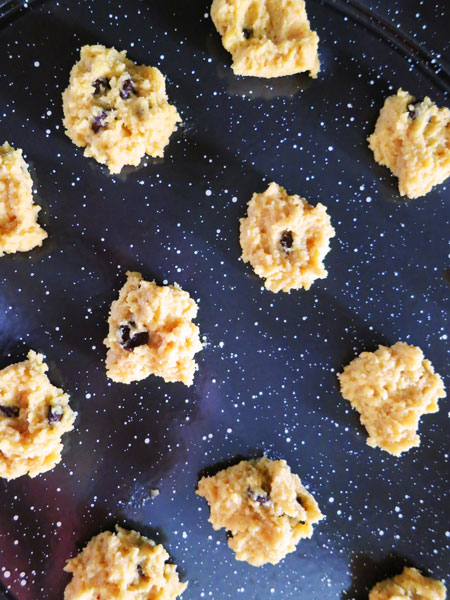
Bake these at 375 for 10 – 12 minutes, remove them from the oven and scarf them up before anyone else sees them! These are a great low carb way to answer the chocolate chip cookie craving, which is absolutely fierce and must be answered. The good news: These are entirely BINGEable – I have eaten half the batch in one sitting and had no blood sugar issues at all. I’ve found them to be priceless while working on reducing insulin resistance, often eating these on the days I’m not doing HIIT (high intensity interval training) when I find myself craving something sweet, filling and “carby” tasting.
The tally here is about 16 of these dee-lish little gems:
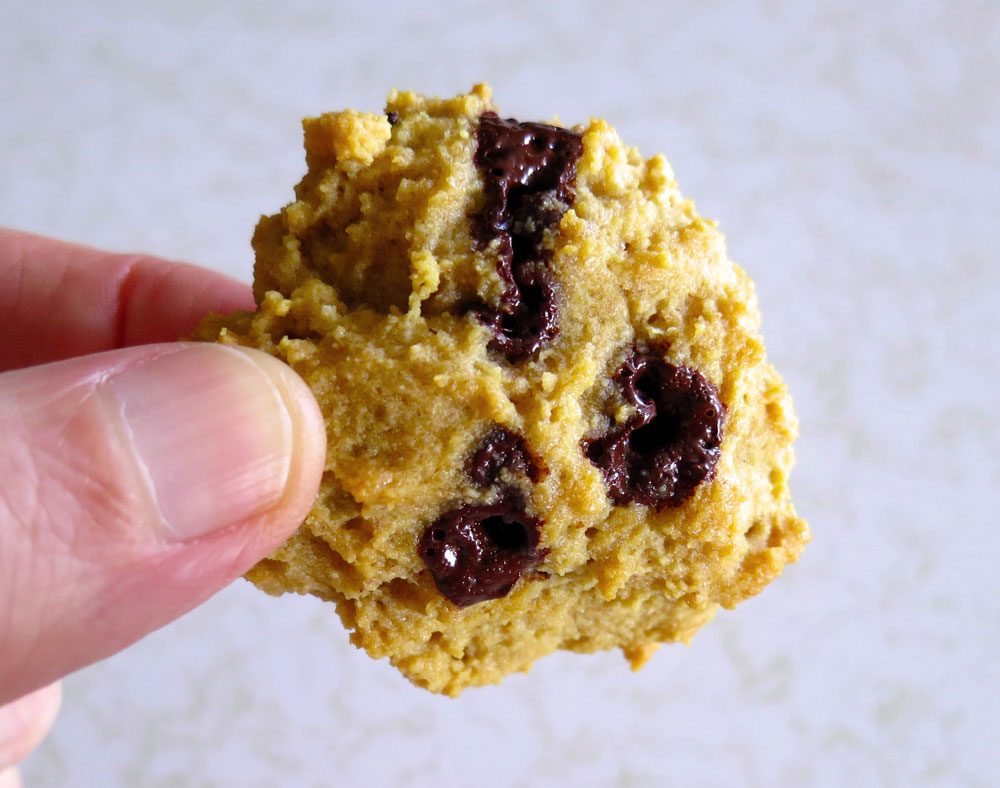
I’m also cooking up a gingerbread version of these…I’ll add that variation in when it’s passed the taste test. Enjoy!
Yours in great health,
Alison
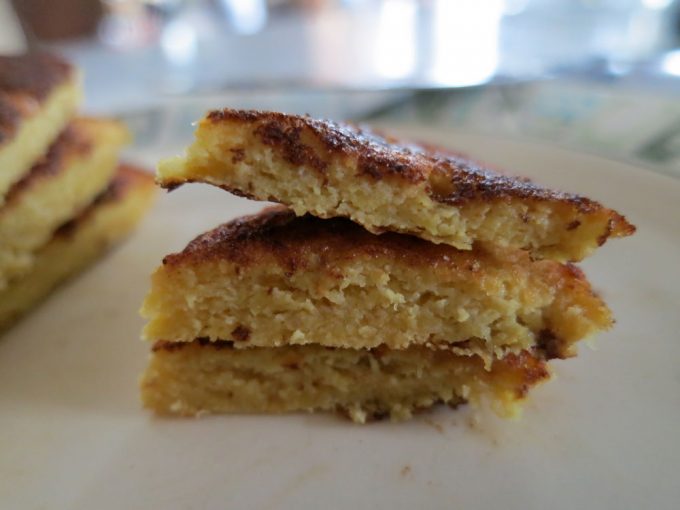
I think I’m in love.
No…really.
I remember when I was a little kid, and had pancakes for breakfast with maple syrup, and I poured so much syrup on my pancakes that they became these soggy-sweet things I just could not get enough of!
That’s what THESE remind me of…WITHOUT THE SYRUPY MESS OR BLOOD SUGAR SPIKE.
I most often eat low carb – and note this is not NO CARB – quality, highly nutritious carbs in low amounts is the key. I’ve been on a mission lately to ramp up the nutritional value of everything I eat, and wherever I can substitute vegetables for flour, I’m all in.
This recipe uses a vegetable – in this case, leftover baked acorn squash, a sweet and mildly starchy veggie known for magnesium, potassium, fiber, vitamin C and vitamin A content, among many other great things. It also makes use of the principle of heating and cooling a starch to increase its resistant starch (i.e., the kind of starch that has some health benefits and does NOT raise your blood sugar). This is called starch retrogradation, according to a healthline.com article titled, “Cooling Some Foods After Cooking Increases Their Resistant Starch,” by Grant Tinsley, PhD. Also check out a very thorough PDF on resistant starch and its benefits and role in healing insulin resistance and the gut.
The recipe also uses monk fruit powder, a zero-sugar sweetener (also known as lo han guo) that, according to Dr. Axe’s website, “has long been regarded as the “longevity fruit” thanks to its high antioxidant levels.”
Per Dr. Axe, it has also been utilized “as a treatment for diabetes, and as a way to clear heat from the body caused by both internal and external source.” This is of big interest to me as someone who experiences blood sugar issues as a component health issue – it seems to go hand-in-hand with the systemic candidiasis, cancer and hormonal issues I deal with. Not to mention my Chinese doc always told me I have a tendency toward damp heat, meaning foods and other things that clear heat are helpful.
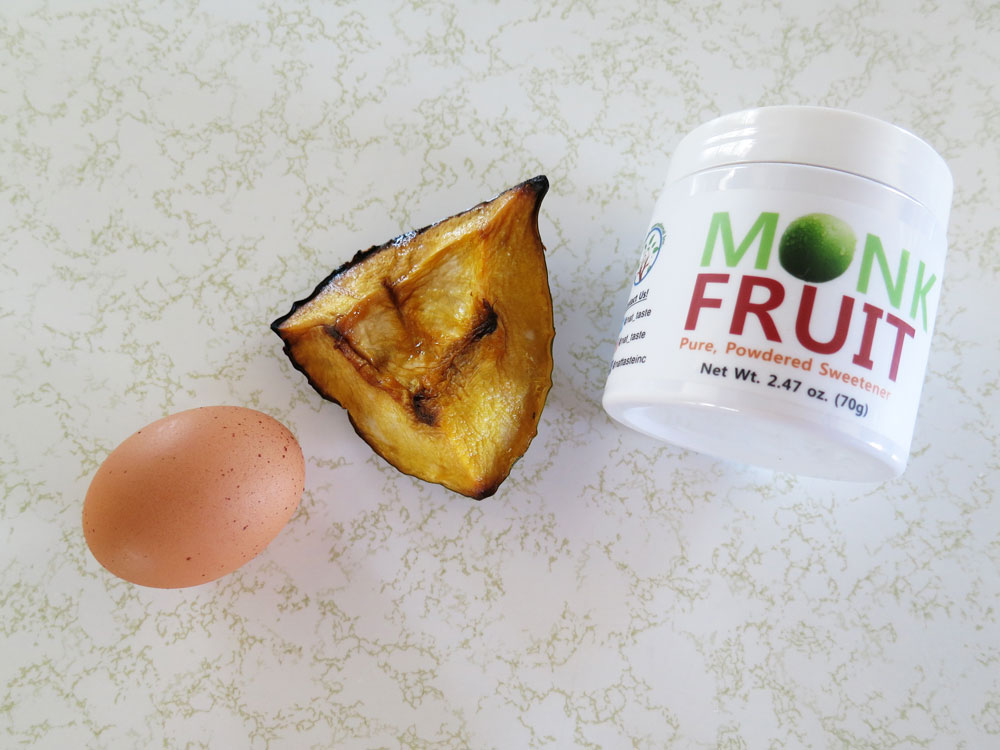
Best of all, these little pancakes only have three ingredients, plus some butter or oil for cooking. As always, I prefer to use organic:
- One Egg
- 1/4 Cup (60 ml) Baked Acorn Squash, Skinned
- 1/4 Teaspoon (2.5 cc/ml) Monk Fruit Powder (Slightly Heaping/To Taste)
Skinning the baked acorn squash is really easy – it usually peels right off once it’s been baked and in the fridge for a bit. I then squeeze it into a 1/4 cup measure:
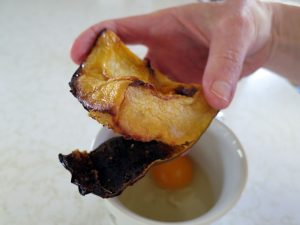
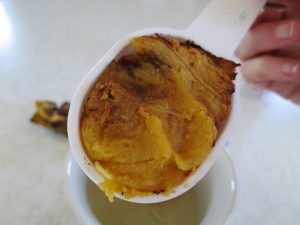
In a small bowl (even a coffee mug works), whisk together the skinned acorn squash and egg with a fork, this might take a few minutes. Mash any stubborn lumps of squash against the side of your bowl using the fork until the batter is smooth:
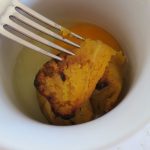
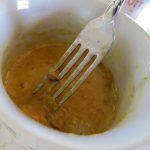

Add in your 1/4 teaspoon (or thereabouts) of monk fruit powder:
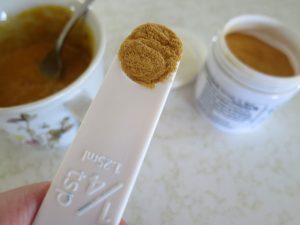
The finished batter should be very smooth:
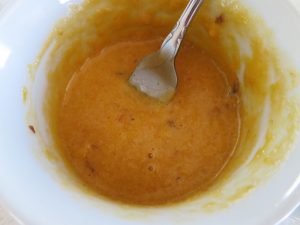
Next, Add butter and/or healthy oil to a frypan, set on medium heat. Using a tablespoon measure, spoon a generous tablespoon’s worth of batter into your frying pan. Cook on each side until browned…the time to flip is when the outer edges become dry. These brown pretty fast, so keep an eye on them! Usually I’ve turned them at around the 2-3 minute mark, but sometimes the second side can take a little less time:
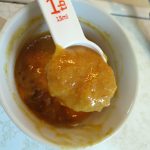
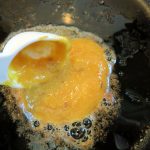

And here’s the final product! This recipe makes about six 2-3 inch pancakes, and you can do a lot with these. They’re great by themselves…
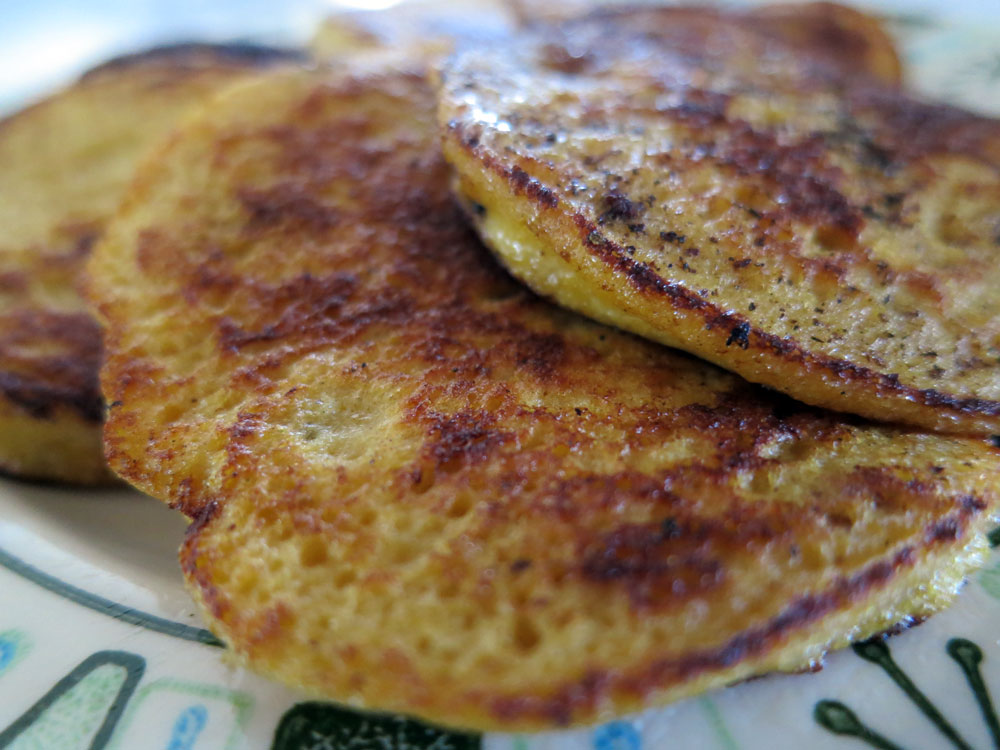
…or as a side dish. Try sprinkling some cinnamon over them, delicious!
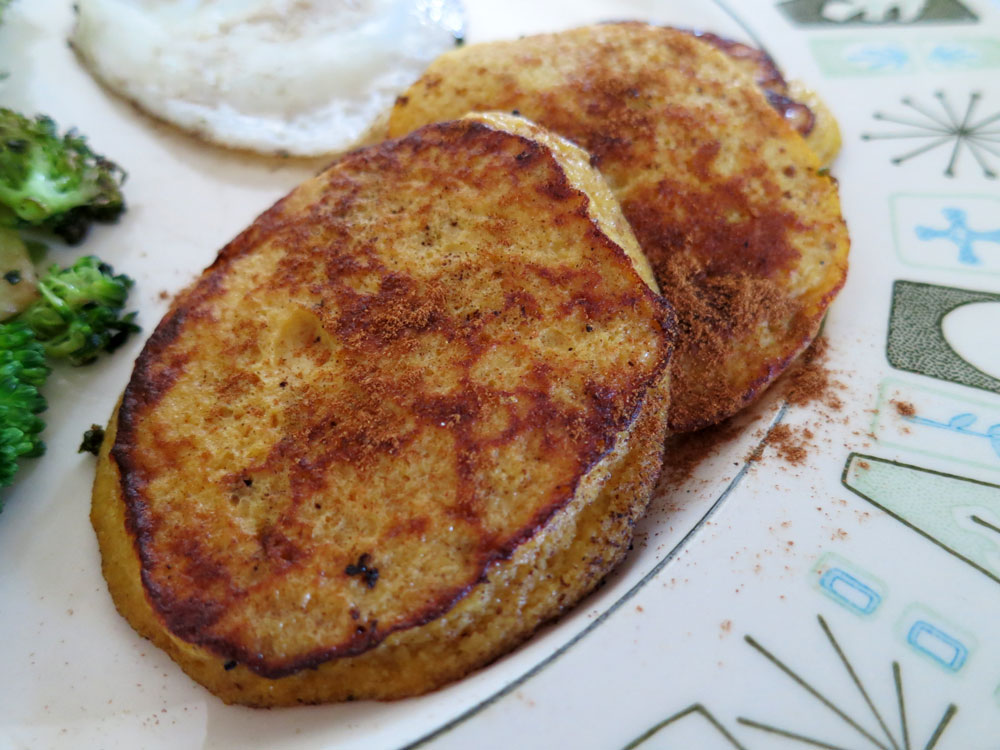
And did I mention these are great for an impromptu layered desert, sans the added sugar? Here, I’ve topped one pancake with plain greek yogurt and a frozen strawberry, which defrosted perfectly by the time I was done my main course…
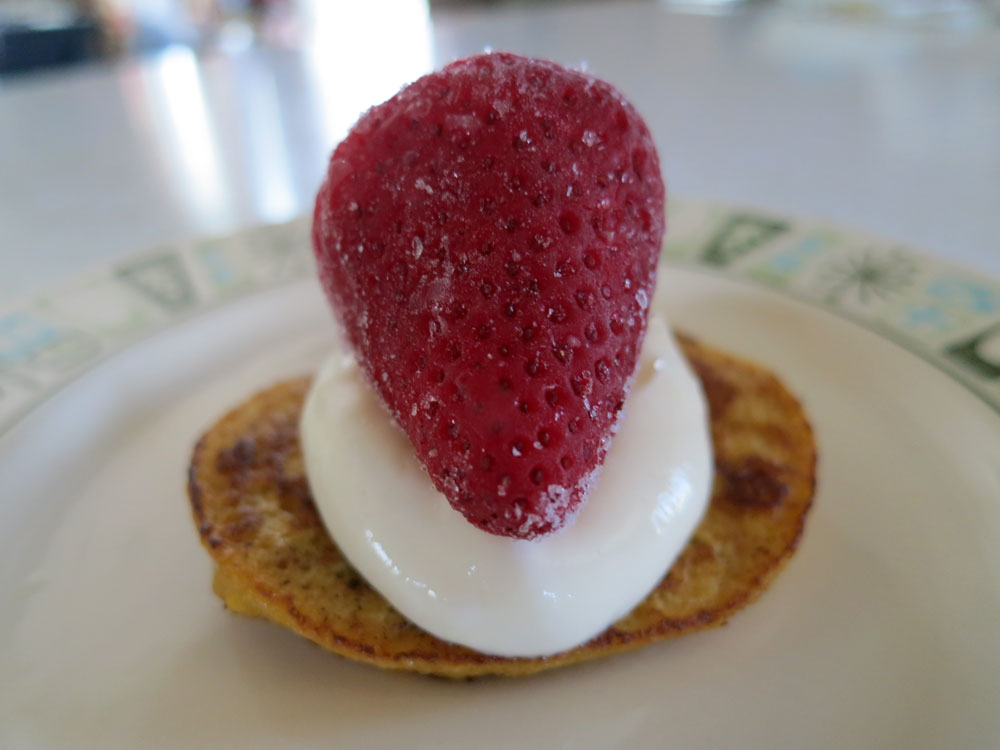
These pancakes are moist, and have a texture kind of like spongecake, which gives me an idea: Why not layer the pancakes with heavy whipped cream or plain greek yogurt (to which I might add some stevia or monk fruit powder to increase the sweetness as needed) and strawberries (or blueberries, etc.) in either clear plastic party cups or a round cake pan, then refrigerate. This would make a very nutritious party dessert without gluten or sugar…and plenty of protein.
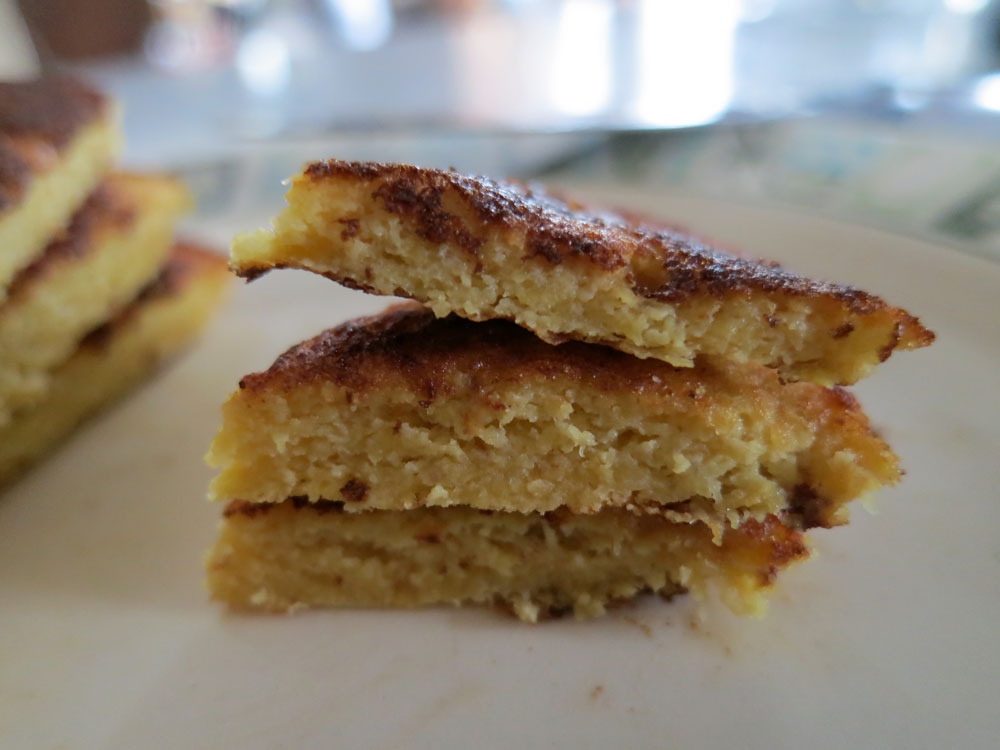
Yield: Six 2-3 inch pancakes. These pancakes can be frozen for later use or stored in the fridge for a few days.
Variations: [Note: I haven’t tried these yet, so look for an update] I’m not sure if it will work, but if you don’t have a sweet tooth, try omitting the monk fruit powder for a 2-ingredient treat. Another variation is to use stevia instead of monk fruit powder, though I like the taste of monk fruit powder in these – it blends in rather well with the acorn squash.
Notes (Based on nutritiondata.self.com): The quarter cup of acorn squash in this recipe has 7.5 grams of carb, 2.25 grams of fiber, negligible sugars, negligible fat and .6 grams of protein. One large fried egg contains .4 grams carbs (no sugars), 7 grams of fat, and 6.3 grams of protein. And according to the container, one quarter teaspoon of monk fruit powder has zero sugars.
Enjoy!
Yours in Great Health,
Alison
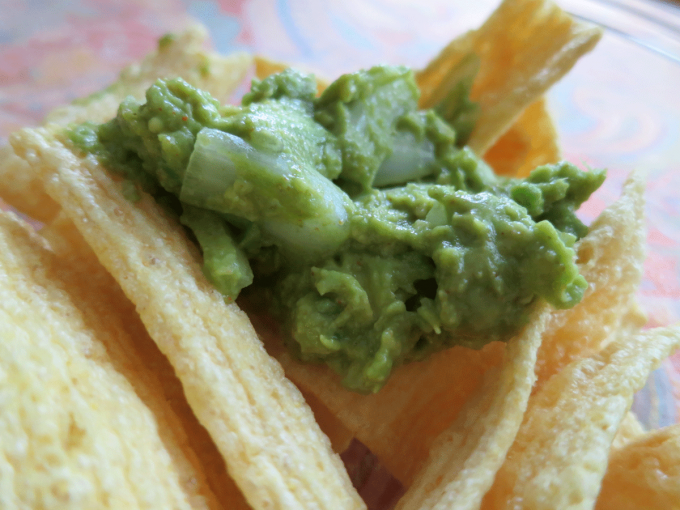
I’m always looking for quick, simple and inexpensive ways to make the good stuff on the go, so here’s one fer ye! It’s a very cool, fast and easy guacamole recipe using readily available & easily found ingredients, straight from your – or your Airbnb host’s – fridge and spice rack. Great when craving something real on the road, or when you need a quick and healthy snack without much fuss.
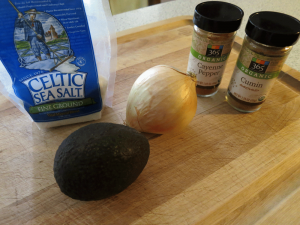
Gather ye thy holy ingredients:
- One Ripe Avocado (Small to Medium)
- 1/4 Fresh Onion (or 1 TB Dried Onion Flakes)
- 1/2 Heaping Teaspoon Cumin Powder
- 1 – 2 Dashes Cayenne Powder
- Scant 1/2 Teaspoon Sea Salt
I try to use all or mostly organic stuff in my cooking and always encourage others to do the same. In a cereal bowl (or similar), cut, skin and mash up the avocado. Save the seed! You’ll need it if you want to refrigerate any leftover guac…according to livescience.com, science does seem to support that keeping the seed with the guac will prevent some browning, and as well, thou shalt hear a voice behind thee, spewing facts regarding the uber-nutritious avocado:
Few people know that the avocado is an ecological anachronism, that it most likely evolved specifically to entice the tastes and the large gullet of the now-extinct giant ground sloth.
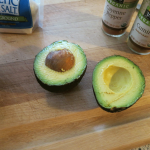
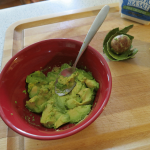
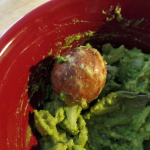
Now that that deadly sin is out of my system, next you’ll want to dice 1/4 of a fresh onion, which equates to approximately 1/4 – 1/3 cup. FYI, if you’re using dried onion flakes, the 4:1 rule applies – in other words, you only need about a quarter the amount of dried onion to get the same taste result. Given that 1/4 cup equates to 4 tablespoons, using 1 tablespoon dried onion flakes will do it. As always, trust your taste buds and adjust accordingly.
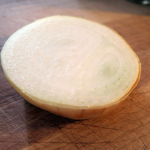
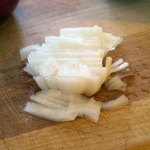
Briefly mix the onion into the mashed avocado:
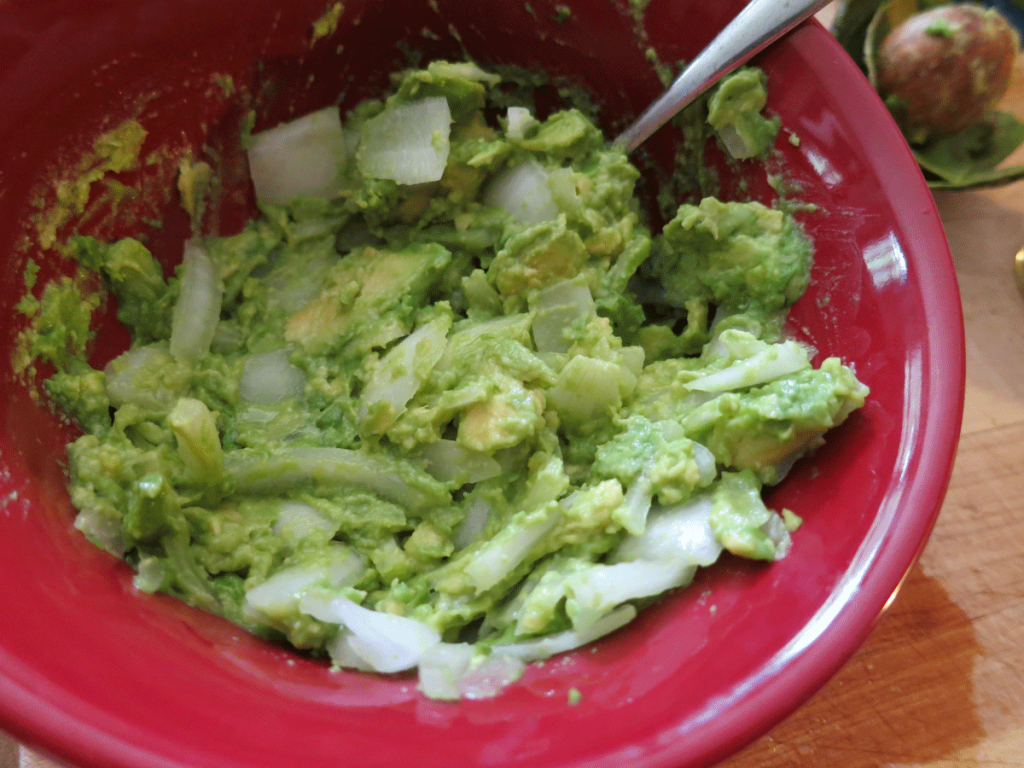
Next, add in your heaping 1/2 teaspoon of cumin powder…
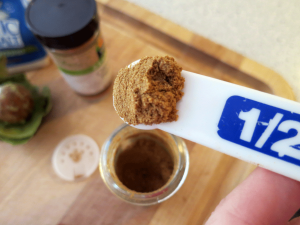
…followed by 1 – 2 dashes of cayenne pepper and a scant 1/2 teaspoon sea salt…
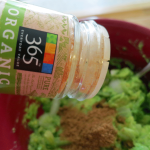
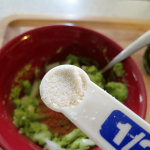
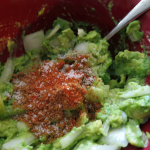
…and you are ready to do the final mix!
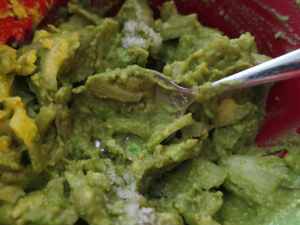
Next, get ready to serve thyself this Simple as Hell Holy Guacamole. Sometimes I eat it straight up, but here, to show some degree of civility, I’ve used lentil chips, which provided a really nice, light contrast to the guac…enjoy!
Serves: 2 normals, or one Alison Lorraine. Can be stored in the fridge for a day with the seed, but it’s best to use this up asap.
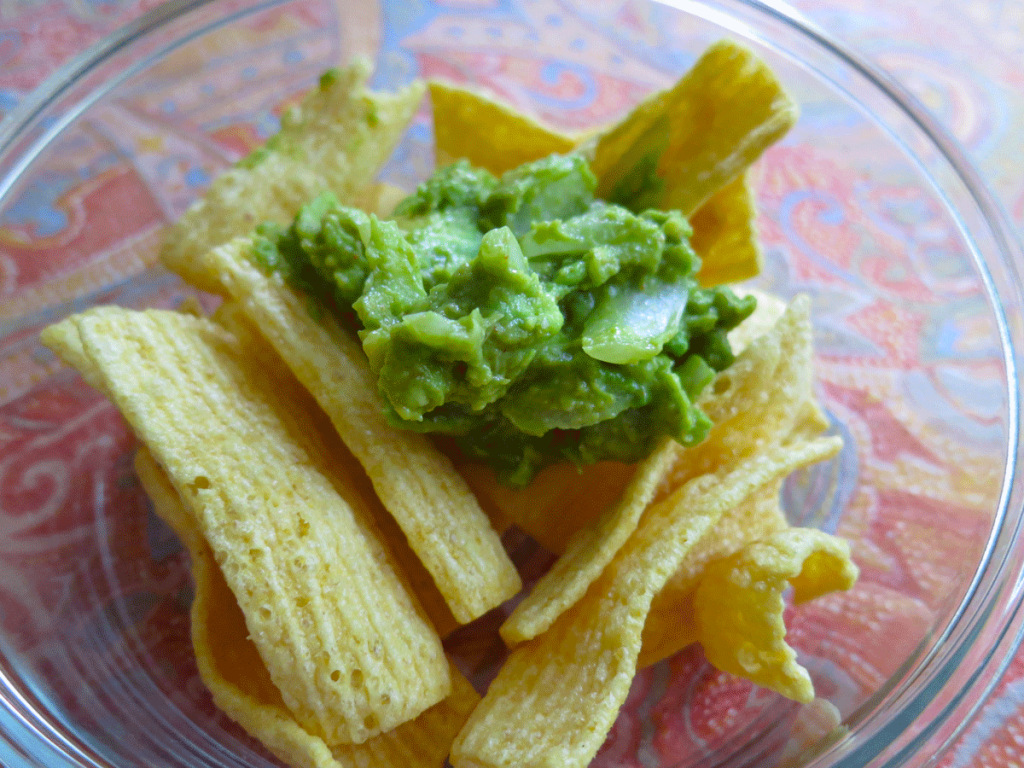
Yours in Great Health,
Alison
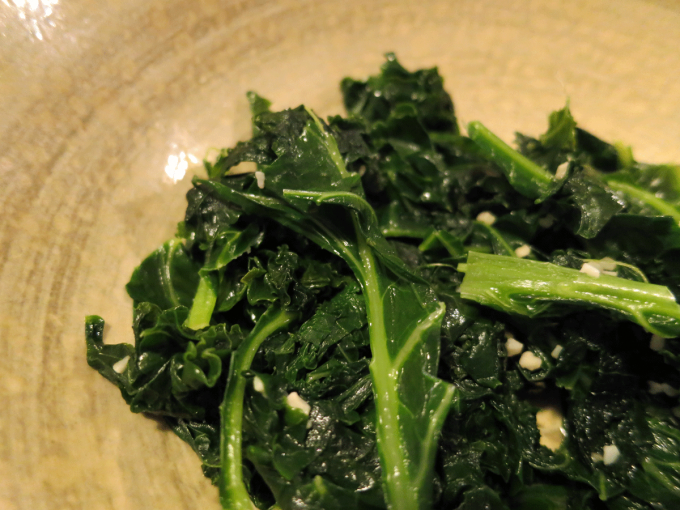
Kale is the green’s green – thick, hearty, and full of nutritional value. And like any self-respecting green, it tastes like one. At least until you add a few simple things, then everything changes. Flavor happens. People start asking you to “make that kale thing you made that other time,” and all sorts of good stuff that’ll lower your karmic debt.
Hell, it’s one way to get some meaningful veggies down your throat!
I cooked this at my best friend Kelly’s house in Pennsylvania. She, like me, is always looking for better eats and health, and well, there I was. This simple dish will add flavor and pleasure to any meal, and is also a pretty good snack on its own.
All you’ll need are:
- One Bunch Organic Kale
- 1 Tsp Dried or One Clove Fresh Garlic, Minced (Organic, if Possible)
- 1/2 Tb Butter
- Sea Salt
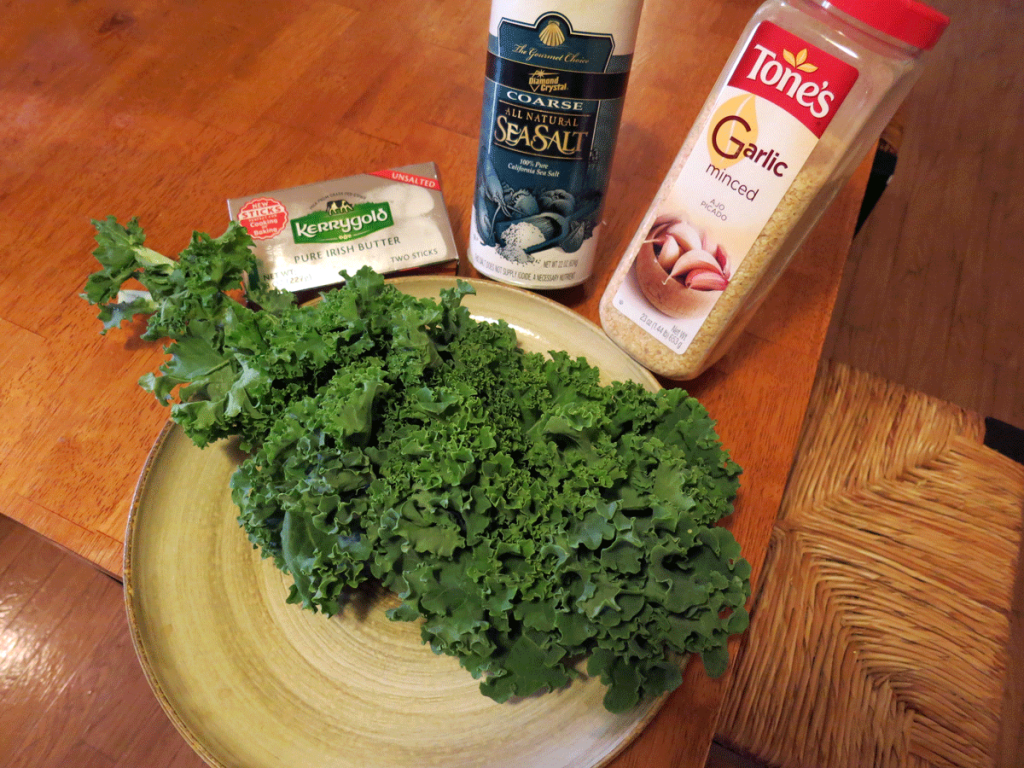
First, you’ll want to disassemble your bunch of kale and slice the leafy parts of the leaves off the stems, rip them into bite-size pieces and place them in a pan with just a little water, say a couple of tablespoons. The easiest and fastest way I’ve found to de-stem kale leaves: Use kitchen shears. They will save you time you will want to waste procrastinating on facebook.
But seriously, a good set of kitchen shears will keep the time spent and the lacerations to a minimum.
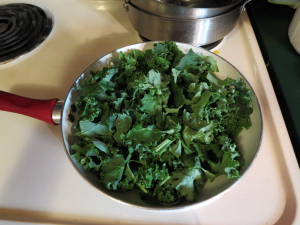

Once the kale is in the pan, cover then heat it on a high heat setting to get the kale to start boiling. Kelly’s stove had knobs like this, so I used an 8 for a gentle boil.
After the kale has boiled for a few minutes and started to darken, add in your garlic, butter and a couple dashes of the sea salt, turning your stove’s heat setting down to medium:
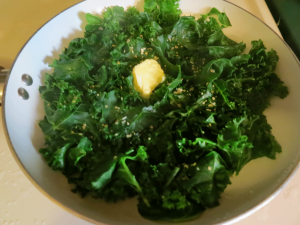

Cover the whole lot and let it simmer for several more minutes. I find that boiling and simmering for a total of 10 minutes works well – it softens the kale and mingles the garlic, butter and sea salt perfectly with it. I like soft kale, not the tough stuff, and I’ll take flavorful versus rabbit food anytime. Stir and taste test a piece when approaching 10 minutes to see if it’s the right amount of doneness for you.
Dee-lish! And a health-giving, colorful addition to any plate. Makes a great, hearty side for red meats, beans, and it’s great with potatoes and other starchy vegetables, such as squashes, or root veggies, like parsnips. Kale pairs well with things that have a sweetness about them, and that makes it one of the sweetest thangs 🙂 …so dig in!
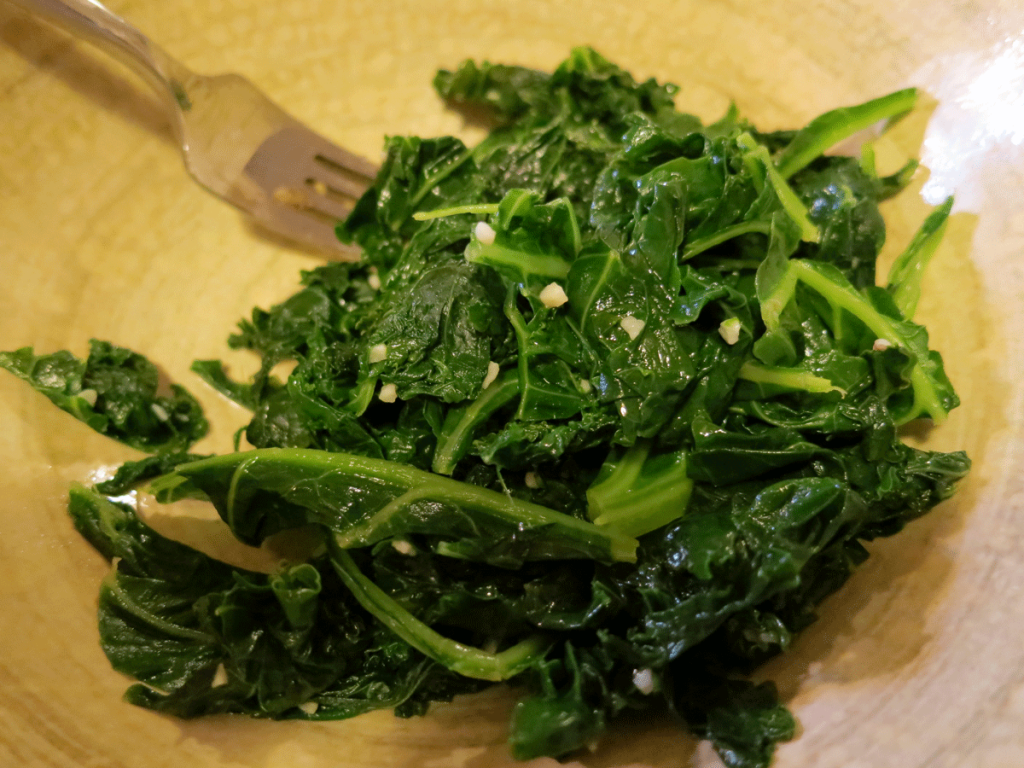
Yours in Great Health,
Alison
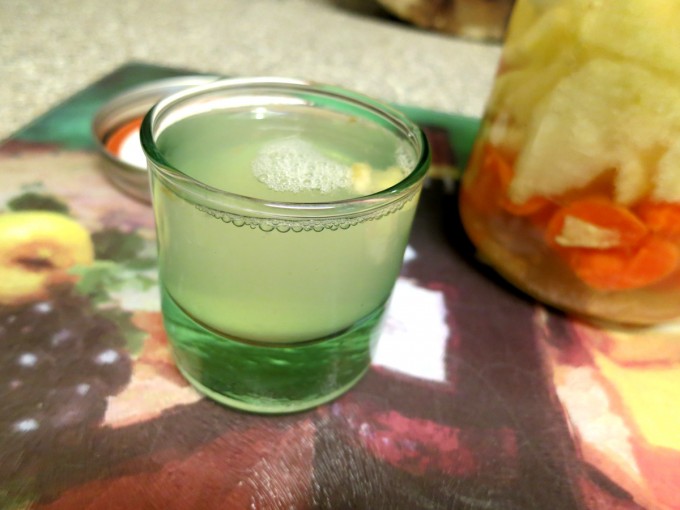
For years, I’d spent considerable money on probiotic supplements, some of them $50 a small bottle (or more). After that, I made water kefir using grains and a kit I’d bought on eBay, which was an interesting experiment in learning how to make yummy freeze-dried strawberry soda. Much cheaper, but it was altogether way too high in sugar.
Flash forward to two months ago when I got a hint from a friend in the know that I could just use some fruit, honey and sea salt to make a fine probiotic drink with a better carb profile…without babysitting any grains or the like. He used some apples, berries and a little bit of honey sans the sea salt for his version, which was where I started. Experimenting some more, I decided to use a time-tested formula that many cancer survivors (and thrivers) I know use for juicing: apples, carrots and ginger root. Except I would ferment them instead of juicing them.
I ended up with a great recipe containing live probiotics that is not only healthful and quite tasty, but produces zero waste in the bargain. Big on taste, zero waste.
Onward. Please gather the following items…and use organic where possible:
- Green Apple
- Mid-sized Carrot
- About 4 cm of Ginger Root (thick, thin, less or more to your taste)
- Heaping Teaspoon of Honey (I use a long teaspoon like the ones I use to stir my iced tea, not a measuring spoon – see pic above)
- 2 – 3 Hearty Pinches of Sea Salt
You will also want to have on hand:
- Small Ceramic (a small ceramic is good – I use a cheesecake ceramic dish borrowed from the Bellagio)
- Wide Mouth Quart or Liter-sized Mason Jar
- Water (Spring is best – enough to nearly fill the Mason Jar)
Rinse the apple and carrot with spring water, brushing lightly and briefly with a veggie brush or a clean scrubbie…don’t overdo it as you want to preserve the soil-based microorganisms that are so beneficial. Slice your carrot into thin slices with knife or kitchen shears into the Mason jar. Eat or compost the ends. Follow with slicing the apple, peel it if you wish and save the peel for either eating or composting…same with the core. The seeds are full of natural, cancer-fighting laetrile and should be eaten with the core while making this drink 🙂
Next, lightly peel and slice your ginger. As with the carrot and apple, the thinner you slice it means more surface area for the good critters to grow on. Follow by adding enough spring water to come up about an inch – 2.5 cm – below the jar’s top lid.
Now, add the honey and pinches of sea salt. Stir until all the honey is dissolved using the long teaspoon. This will take a few minutes, and will get all the ingredients mixing together nicely for the fermentation. The honey and salt may seem counter-intuitive, but these are essential for minimizing any bad critters that might try to grow into your mix.
You’ll notice the apples will float, so the next step is to place your ceramic carefully into the jar such that it keeps all the fruit and veggies down. Use the long teaspoon for this as well.
If the water level comes to about 1 – 1.5 cm – or about half an inch – below the jar’s top lid, you’re golden. Seal it up! If it’s not quite there, add a little water. If it’s too close to the lid, spoon off a couple spoonfuls into a shot glass and drink up.
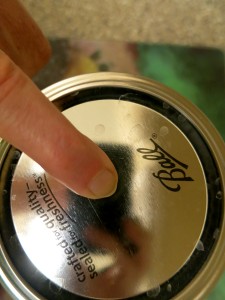 Let the mixture sit for 2-3 days before tasting. You should see small bubbles start to form, and when the lid cannot be pressed down, it is a good sign that you’ve got a good fermentation going. Letting the mixture ferment for 3 days is good before taking the first drinks, and I keep my shot glass nearby for the purpose. Smell the mix, if it smells warm and mildly sweet, you’re doing great. The Day 3 mix tastes mostly mellow and sweet, maybe a little tang, and just a little bite-y or fizzy. The longer you ferment, the more the sourness of the flavor grows…and I’ll point out here that it is good to smell the mix to make sure it hasn’t gone “off” – truth be told, I’ve never had a bad mix, but use common sense, pretty please.
Let the mixture sit for 2-3 days before tasting. You should see small bubbles start to form, and when the lid cannot be pressed down, it is a good sign that you’ve got a good fermentation going. Letting the mixture ferment for 3 days is good before taking the first drinks, and I keep my shot glass nearby for the purpose. Smell the mix, if it smells warm and mildly sweet, you’re doing great. The Day 3 mix tastes mostly mellow and sweet, maybe a little tang, and just a little bite-y or fizzy. The longer you ferment, the more the sourness of the flavor grows…and I’ll point out here that it is good to smell the mix to make sure it hasn’t gone “off” – truth be told, I’ve never had a bad mix, but use common sense, pretty please.
I find that Day 4 produces the flavor and the amount of fizz (quite a bit!) in the drink that I like most, so I take the most shots on this day…and yes, I’ve even had “die-off” or Herxheimers on occasion – this stuff does the job. After Day 4, I either let it sit out one more day and drink a more sour version, or I put in in the fridge on Day 4 to slow down the fermentation, though this reduces the fizz to almost nothing. I try and use up everything, liquid, solids and all, by Day 5. That seems to be the optimal time frame for taste, etc.
I often add a small amount of stevia to my shot glass with the probiotic drink – delicious! It tastes like a fizzy, slightly soured version of ginger ale, the stevia adding just the right amount of sweetness to make a sweet-tart and healthful drink.
As you drink and the liquid level lowers, the remaining apple-carrot-ginger solids and liquid can be refrigerated for a kvass-style probiotic digestive (click the “+” button at the top right of this page to see that image) that makes a great and very healthful side dish to any meal. Just a spoonful or two is wonderful, and soon you’ll have consumed all the liquid and the solids, meaning zero waste for this one.
Enjoy!
Yours in Great Health,
Alison

